Sicily
Sicily
| |
|---|---|
| Anthem:Madreterra | |
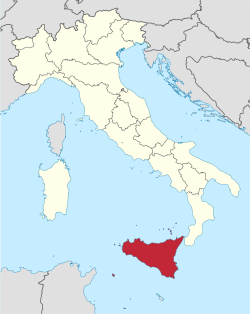 | |
| Country | |
| Capital | Palermo |
| Government | |
| •President | Renato Schifani(FI) |
| Area | |
| • Total | 25,832 km2(9,974 sq mi) |
| Population (2021)[1](8.3% of Italy) | |
| • Total | 4,833,329 |
| • Density | 190/km2(480/sq mi) |
| Demonym(s) | English:Sicilian Italian:Siciliano(man) Italian:Siciliana(woman) |
| Citizenship | |
| • Italian | 98% |
| GDP | |
| • Total | €88.767 billion (2021) |
| Time zone | UTC+1(CET) |
| • Summer (DST) | UTC+2(CEST) |
| ISO 3166 code | IT-82 |
| HDI(2021) | 0.847[4] very high·21st of 21 |
| NUTS Region | ITG |
| Website | www |


Sicily(Italian:Sicilia,pronounced[siˈtʃiːlja];Sicilian:Sicilia,pronounced[sɪˈ(t)ʃiːlja]) is the largest and most populous island in theMediterranean Seaand one of the 20regionsofItaly.It is one of the fiveItalian autonomous regionsand is officially referred to asRegione Siciliana.The island has 4.8 million inhabitants. Itscapital cityisPalermo.It is named after theSicels,who inhabited the eastern part of the island during theIron Age.Sicily has a rich and unique culture inarts,music,literature,cuisine,andarchitecture.
Sicily is located in the central Mediterranean Sea, south of theItalian Peninsulaincontinental Europe;it is separated fromCalabriaby theStrait of Messina.Its most prominent landmark isMount Etna,the tallest activevolcanoin Europe, and one of the most active in the world, currently 3,357 m (11,014 ft) high. The island has a typicalMediterranean climate.
The earliestarchaeological recordof human activity on the island is from around 14,000 BC. By around 750 BC, Sicily had threePhoenicianand a dozenGreek coloniesalong its coasts, becoming one of the centers ofMagna Graecia.TheSicilian Warsof 580–265 BC were fought between the Carthaginians and Greeks, and thePunic Warsof 264–146 BC were fought between Rome and Carthage. The Roman province ofSiciliaended with the fall of theRoman Empirein the 5th century AD. Sicily was ruled during theEarly Middle Agesby theVandals,theOstrogoths,theByzantine Empire,and theEmirate of Sicily.
TheNorman conquest of southern Italyled to the creation of theCounty of Sicilyin 1071, that was succeeded byKingdom of Sicily,a state that existed from 1130 until 1816 under various dynasties,[5][6]and in 1816 it was unified with theKingdom of Naplesinto theKingdom of the Two Sicilies.From the 1282Sicilian Vespersuntil the 1860Expedition of the Thousand,Sicily was ruled byAragonand thenSpain,either inpersonal unionwith the crown or by acadet branch,with the exception of a period ofSavoyand thenHabsburgrule in 1713–1735.
The island became part of thenewly unifiedItalyin 1860 following the Expedition of the Thousand, an invasion led byGiuseppe Garibaldi,and a plebiscite. Sicily was given special status as anautonomous administrative divisionon 15 May 1946, 18 days before the1946 Italian institutional referendum.
Geography
[edit]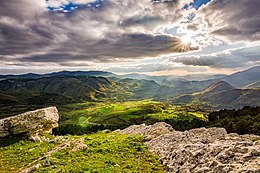
Sicily has a roughly triangular shape, earning it the nameTrinacria.
To the north-east, it is separated fromCalabriaand the rest of the Italian mainland by theStrait of Messina,about 3 km (1.9 mi) wide in the north, and about 16 km (9.9 mi) wide in the southern part.[7]The northern and southern coasts are each about 280 km (170 mi) long measured as a straight line, while the eastern coast measures around 180 km (110 mi); total coast length isestimatedat 1,484 km (922 mi). The total area of the island is 25,711 km2(9,927 sq mi),[8]while theAutonomous Regionof Sicily (which includes smaller surrounding islands) has an area of 27,708 km2(10,698 sq mi).[9]
The terrain of inland Sicily is mostly hilly and is intensively cultivated wherever possible. Along the northern coast, themountain rangesofMadonie,2,000 m (6,600 ft),Nebrodi,1,800 m (5,900 ft), andPeloritani,1,300 m (4,300 ft), are an extension of the mainlandApennines.The cone ofMount Etnadominates the eastern coast. In the southeast lie the lowerHyblaean Mountains,1,000 m (3,300 ft).[10]The mines of theEnnaandCaltanissettadistricts were part of a leadingsulphur-producing area throughout the 19th century, but have declined since the 1950s.
Sicily and its surrounding small islands have some highly active volcanoes. This is due to Sicily being geographically on the northern edge of theAfrican Plate.[11]Mount Etna is the largest active volcano in Europe and casts black ash over the island with its recurrent eruptions. It stands 3,329 metres (10,922 ft) high, though this varies with summit eruptions; the mountain is 21 m (69 ft) lower now than it was in 1981. It is the highest mountain in Italy south of theAlps.Etna covers an area of 1,190 km2(459 sq mi) with a basal circumference of 140 km (87 mi). This makes it the largest of the threeactive volcanoes in Italy,being about two and a half times the height of the next largest,Mount Vesuvius.InGreek mythology,the deadly monsterTyphonwas trapped under the mountain byZeus,the god of the sky.[12]Mount Etna is widely regarded as a cultural symbol and icon of Sicily.

TheAeolian Islandsin theTyrrhenian Sea,to the northeast of mainland Sicily form a volcanic complex.
The three volcanoes ofVulcano,StromboliandLipariare also active, although the latter is usually dormant. Off the southern coast of Sicily, the underwater volcano ofFerdinandea,which is part of the largerEmpedocles volcano,last erupted in 1831. It is located between the coast ofAgrigentoand the island ofPantelleria(which itself is a dormant volcano).
From a geographical perspective, also forming a part of Sicily is the Maltese Archipelago, the islands home to therepublic of Malta.
Theautonomous regionalso includes several neighbouring islands: theAegadian Islands,the Aeolian Islands, Pantelleria andLampedusa.
Mountains
[edit]The mountains of Sicily form a significant part of the island's diverse landscape, withMount Etna,one of the world's most active volcanoes, being the highest and most notable peak. Other important mountain ranges include theNebrodi,MadonieandPeloritanimountains ranges.
Five tallest mountains of Sicily:
| Name | Height (meters) | Height (feet) |
|---|---|---|
| Mount Etna | 3,357 | 11,014 |
| Pizzo Carbonara | 1,979 | 6,493 |
| Monte Soro | 1,853[13] | 6,079 |
| Rocca Busambra | 1,613 | 5,292 |
| Monte San Calogero | 1,326[14] | 4,318 |
Rivers
[edit]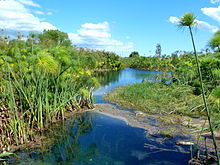
Several riversdrainthe island, most of which flow through the central area and enter the sea at the south of the island. TheSalsoflows through parts of Enna and Caltanissetta before entering theMediterranean Seaat theportofLicata.To the east, theAlcantaraflows through the province ofMessinaand enters the sea atGiardini Naxos,and theSimeto,which flows into theIonian Seasouth ofCatania.Other important rivers on the island are theBeliceandPlataniin the southwest.
| River | Length |
|---|---|
| Salso | 144 km (89 mi) |
| Simeto | 113 km (70 mi) |
| Belice | 107 km (66 mi) |
| Dittaino | 105 km (65 mi) |
| Platani | 103 km (64 mi) |
| Gornalunga | 81 km (50 mi) |
| Gela | 74 km (46 mi) |
| Salso Cimarosa | 72 km (45 mi) |
| Torto | 58 km (36 mi) |
| Irminio | 57 km (35 mi) |
| Dirillo | 54 km (34 mi) |
| Verdura | 53 km (33 mi) |
| Alcantara | 52 km (32 mi) |
| Tellaro | 45 km (28 mi) |
| Anapo | 40 km (25 mi) |
Climate
[edit]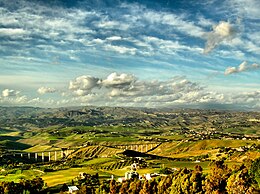
Sicily has for the most part a typicalMediterranean climate(Köppen climate classification:Csa) with mild and wet winters and hot, dry summers with changeable intermediate seasons. On the coasts, especially in the southwest, the climate is affected by the African currents and summers can be hot.
Snow falls above 900 metres, but it can fall in the hills. The interior mountains, especiallyNebrodi,Madonie,andEtna,enjoy a mountain climate, with heavy snowfalls during winter. The summit of Mount Etna is usually snow-capped from October to May.
In the summer, thesirocco– the wind from the Sahara – can be felt. Rainfall is scarce, and in some provinces a water crisis can occur.
According to the Regional Agency for Waste and Water, on 10 August 1999, the weather station ofCatenanuova(EN) recorded an unofficial maximum temperature of 48.5 °C (119 °F).[15]On 11 August 2021, a newhighest temperature recordforEuropewith a reading of 48.8 °C (119.8 °F) was set near the city ofSyracuse.[16]Total precipitation is highly variable, generally increasing with elevation. In general, the southern and southeast coast receives the least rainfall (less than 50 cm (20 in)), and the northern and northeastern highlands the most (over 100 cm (39 in)).
Flora and fauna
[edit]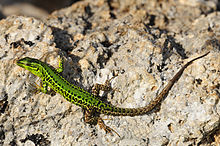
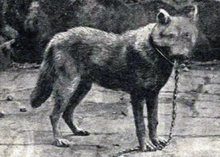
Sicily is an often-quoted example of man-madedeforestation,which has occurred since Roman times when the island was turned into an agricultural region.[10]This gradually dried the climate, leading to a decline in rainfall and the drying of rivers. The central and southwest provinces are practically devoid of forest.[17]In Northern Sicily, there are three important forests; near Mount Etna, in theNebrodi Mountainsand in theBosco della FicuzzaNatural Reserve nearPalermo.The Nebrodi Mountains Regional Park, established on 4 August 1993 and covering 86,000 hectares (210,000 acres), is the largest protected natural area of Sicily; it contains the largest forest in Sicily, theCaronia.TheHundred Horse Chestnut(Castagno dei Cento Cavalli), inSant'Alfio,on the eastern slopes of Mount Etna, is the largest and oldest knownchestnuttree in the world at 2,000–4,000 years old.[18]
Sicily has a wide variety of fauna. Species include theEuropean wildcat,red fox,least weasel,pine marten,fallow deer,[19]wild boar,crested porcupine,European hedgehog,common toad,Vipera aspis,golden eagle,peregrine falcon,Eurasian hoopoeandblack-winged stilt.[20]Roe deerwere driven to extinction on the island.[21]TheSicilian wolf(Canis lupus cristaldii) was anendemicwolfsubspeciesthat was driven to extinction in the 20th century. During theLate Pleistocene,a species ofdwarf elephant,Palaeoloxodon mnaidriensisinhabited the island, with its latest records on Sicily dating to around 20,000 years ago.[22]
TheRiserva naturale dello Zingaro(Zingaro Natural Reserve) is one of the best examples of unspoiled coastal wilderness in Sicily.[23]
Marine Life of the Straits of Messinaincludes varieties of birds and marine life, including larger species such asgreater flamingoandfin whale.
History
[edit]The nameSiciliawas given to theRoman provincein 241 BC. It is named after theSicels,who inhabited the eastern part of the island during theIron Age.
The ancient name of the island isTrinacria(GreekΤρινακρία"having three headlands" ) for its triangular shape, likely a re-interpretation of earlier (Homeric)Thrinacia.The Greek name was rendered asTrīnācrĭainclassical Latin(Virgil,Ovid).[24][25]
Prehistory
[edit]

Humans first colonized Sicily towards the end of theLate Pleistocene,around 16,000 years ago, by people associated with theEpigravettianculture.[26]
Discoveries ofdolmenson the island (dating to the second half of the third millennium BC) seem to offer new insights into the culture of primitive Sicily.[27]The impact of at least two influences is clear: the European one coming from the Northwest, and the Mediterranean influence of an eastern heritage.[28]
Antiquity
[edit]


The original classical-era inhabitants of Sicily comprised three defined groups of theancient peoples of Italy:theSicani,theElymiansand theSicels.The most prominent and by far the earliest of these were theSicani,who (Thucydideswrites) arrived from theIberian Peninsula(perhapsCatalonia).[29][30]Some modern scholars, however, suggest classifying the Sicani as possibly anIllyriantribe.[31]Important historical evidence has been discovered in the form of cave drawings by the Sicani, dated from the end of thePleistoceneepoch around 8000 BC.[32]TheElymians,thought to have come from the area of theAegean Sea,became the next tribe to join the Sicanians on Sicily.[33]
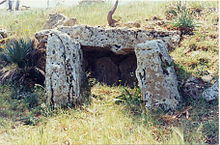
No evidence survives of warring between tribes, but the Sicanians moved eastwards when the Elymians settled in the northwest corner of the island. TheSicelsare thought[32]to have originated inLiguria;they arrived from mainland Italy in 1200 BC and forced the Sicanians to move back across Sicily and to settle in the middle of the island.[32]Other minorItalic groupswho settled in Sicily included theAusones(Aeolian Islands,Milazzo) and theMorgetesofMorgantina.
ThePhoeniciansettlements in the western part of the island predate the arrival ofGreekcolonists.[34]From about 750 BC, the Greeks began to live in Sicily (Ancient Greek:Σικελία–Sikelia), establishing many significant settlements. The most important colony was inSyracuse;others grew up atAkragas,Selinunte,Gela,HimeraandZancle.[35]The native Sicani and Sicel peoples becameabsorbedinto theHellenic culturewith relative ease, and the area became part ofMagna Graeciaalong with the coasts of thesouth of the Italian peninsula,which the Greeks had also colonised. Sicily had fertile soils, and the successful introduction ofolivesandgrape vinesfostered profitable trading.[36]Greek culturesignificantly includedGreek religion,and the settlers built manytemplesthroughout Sicily, including several in theValley of the TemplesatAgrigento.[37]
Politics on the island became intertwined with those of Greece;Syracusebecame desired by theAthenianswho set out on theSicilian Expedition(415–413 BC) during thePeloponnesian War.Syracuse gainedSpartaandCorinthas allies and, as a result, defeated the Athenian expedition. The victors destroyed the Athenian army and their ships, selling most of the survivors intoslavery.[38]

Greek Syracuse controlled eastern Sicily whileCarthagecontrolled the West.[39]The two cultures began to clash, leading to theGreek-Punic wars(between 580 and 265 BC). The Greek states had begun to make peace with theRoman Republicin 262 BC,[citation needed]and the Romans sought toannexSicily as their republic's firstprovince.Rome attacked Carthage's holdings in Sicily in theFirst Punic War(264 to 241 BC) and won, making Sicily the first Roman province outside of theItalian Peninsulaby 242 BC.[40]
In theSecond Punic War(218 to 201 BC), the Carthaginians attempted to recapture Sicily. Some of the Greek cities on the island sided with the Carthaginians.Archimedes,who lived in Syracuse, helped the Carthaginians; Roman troops killed him after they invaded Syracuse in 213 BC.[41]The Carthaginian attempt failed, and Rome became more unrelenting in its annihilation of the invaders;Roman consulM. Valeriantold theRoman Senatein 210 BC that "no Carthaginian remains in Sicily".[42]
As the Roman Republic'sgranary,Sicily ranked as an important province, divided into twoquaestorships:Syracuse to the east andLilybaeumto the west.[34]Roman rule introduced theLatin languageto the island, which underwent a slow process oflatinisationbut Sicily was remained largely Greek in a cultural sense and the Greek language did not become extinct on the island, facilitating itsre-hellenisationunder the Byzantines.[34]The once prosperous and contented island went into sharp decline whenVerresbecame governor of Sicily (73 to 71 BC). In 70 BC noted figureCicerocondemned the misgovernment of Verres in his orationIn Verrem.[43]
Various groups used the island as a power base at different times: slave insurgents occupied it during theFirst(135−132 BC) andSecond(104−100 BC)Servile Wars.Sextus Pompeyhad his headquarters there during theSicilian revoltof 44 to 36 BC. Christianity first appeared in Sicily during the years following AD 200; between this time and AD 313, when EmperorConstantine the Greatlifted the prohibition on Christianity, a significant number ofSicilianshad becomemartyrs,includingAgatha,Christina,Lucy,andEuplius.[44]Christianity grew rapidly in Sicily over the next two centuries.[citation needed]Sicily remained a Roman province for around 700 years.[44]
Germanic rule (469–535)
[edit]TheWestern Roman Empirebegan falling apart after the invasion ofVandals,Alans, and Suevesacross the Rhineon the last day of 406. Eventually the Vandals, after roaming about western and southernHispania(present-dayIberia) for 20 years, moved to North Africa in 429 and occupied Carthage in 439. The Franks moved south from present-day Belgium. The Visigoths moved west and eventually settled in Aquitaine in 418; the Burgundians settled in present-day Savoy in 443.
The Vandals found themselves in a position to threaten Sicily – only 100 miles away from their North African bases.[45]After taking Carthage, the Vandals, personally led by KingGaiseric,laid siege to Palermo in 440 as the opening act in an attempt to wrest the island from Roman rule.[46]The Vandals made another attempt to take the island one year after the 455 sack of Rome, at Agrigento, but were defeated decisively byRicimirin anaval victory off Corsicain 456.[47]The island remained under Roman rule until 469. The Vandals lost possession of the island 8 years later in 477 to theEast Germanic tribeof theOstrogoths,who then controlled Italy and Dalmatia.[45]The island was returned to the Ostrogoths by payment of tribute to their kingOdoacer.He ruled Italy from 476 to 488 in the name of theByzantine (Eastern Roman)Emperor. The Vandals kept a toehold inLilybaeum,a port on the west coast. They lost this in 491 after making one last attempt to conquer the island from this port.[48]The Ostrogothic conquest of Sicily (and of Italy as a whole) underTheodoric the Greatbegan in 488. The Byzantine EmperorZenohad appointed Theodoric as a military commander in Italy. The Goths were Germanic, but Theodoric fostered Roman culture and government and allowed freedom of religion.[49]In 461 from the age of seven or eight until 17 or 18 Theodoric had become a Byzantine hostage; he resided in the great palace of Constantinople, was favored by EmperorLeo I(r. 457–474) and learned to read, write and do arithmetic.[50]
Byzantine period (535–827)
[edit]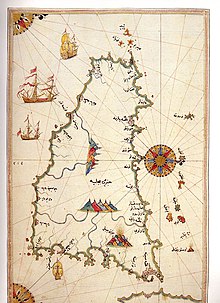
After taking areas occupied by the Vandals in North Africa,Justinian Iretook Italy as an ambitious attempt to recover the lost provinces in the West. The re-conquests marked an end to over 150 years of accommodationist policies with tribal invaders. His first target was Sicily (known as theGothic War (535–554)began between the Ostrogoths and the Eastern Roman Empire, also known as theByzantine Empire). His generalBelisariuswas assigned the task.[51]Sicily was used as a base for the Byzantines to conquer the rest of Italy, withNaples,Rome, andMilan.It took five years before the Ostrogoth capitalRavennafell in 540.[52]However, the new Ostrogoth kingTotilacounterattacked, moving down the Italian peninsula, plundering and conquering Sicily in 550. Totila was defeated and killed in theBattle of Taginaeby Byzantine generalNarsesin 552 but Italy was in ruins.[52]
At the time of the reconquest Greek was still the predominant language spoken on the island. Sicily was invaded by theArab forcesofCaliph Uthmanin 652, but the Arabs failed to make permanent gains. They returned to Syria with their booty.[53]Raids seeking loot continued until the mid-8th century.[54]
The Eastern Roman EmperorConstans IImoved fromConstantinopletoSyracusein 660. The following year he launched an assault from Sicily against theLombardDuchy of Benevento,which occupied most of southern Italy.[55]Rumors that the capital of the empire was to be moved to Syracuse probably cost Constans his life, as he was assassinated in 668.[55]His sonConstantine IVsucceeded him. A brief usurpation in Sicily byMezeziuswas quickly suppressed by this emperor. Contemporary accounts report that the Greek language was widely spoken on the island during this period.[56]In 740 EmperorLeo III the Isauriantransferred Sicily from the jurisdiction of the church of Rome to that of Constantinople, placing the island within the eastern branch of the Church.[57]
In 826Euphemius,the Byzantine commander in Sicily, having apparently killed his wife, forced a nun to marry him. EmperorMichael IIcaught wind of the matter and ordered general Constantine to end the marriage and cut off Euphemius' head. Euphemius rose up, killed Constantine, and then occupied Syracuse; he, in turn, was defeated and driven out to North Africa.[58]He offered the rule of Sicily toZiyadat Allah,theAghlabidEmir ofTunisia,in return for a position as a general and a place of safety. AMuslim armywas then sent to the island consisting ofArabs,Berbers,Cretans,andPersians.[58]
TheMuslim conquest of Sicilywas a see-saw affair and met with fierce resistance. It took over a century for Byzantine Sicily to be conquered; the largest city, Syracuse, held out until 878 and the Greek city ofTaorminafell in 962. It was not until 965 that all of Sicily was conquered by theArabs.[58]In the 11th-century Byzantine armies carried out a partial reconquest of the island underGeorge Maniakes,but it was theirNormanmercenaries who would eventually complete the island's reconquest at the end of the century.
Arab period (827–1091)
[edit]
The Arabsinitiated land reforms,which increased productivity and encouraged the growth ofsmallholdings,undermining the dominance of thelatifundia.TheArabsfurther improved irrigation systems. The language spoken in Sicily under Arab rule wasSiculo-ArabicandArabic influenceis present in some Sicilian words today. Although long extinct in Sicily, the language has developed into what is now theMaltese languageon the islands ofMaltatoday.[59]
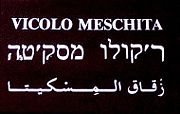
A description ofPalermowas given byIbn Hawqal,anArab merchantwho visited Sicily in 950. A walled suburb, called the Al-Kasr (the palace), is the centre of Palermo to this day, with the great Friday mosque on the site of the later Roman cathedral. The suburb of al-Khalisa (modernKalsa) contained theSultan's palace, baths, a mosque, government offices, and a private prison.Ibn Hawqalestimated there were 7,000 butchers trading in 150 shops. During Muslim rule agricultural products such as oranges, lemons,pistachiosandsugarcanewere brought to Sicily.[45]Western Sicily was overwhelmingly Muslim, and contained large plantations run by slave labor, often producing sugar.[58]Around 1050, the western half of Sicily was ethnically and culturally distinct from central and eastern Sicily. During this time, there was also a small Jewish presence in Sicily, evidence seen in the catacombs discovered on the island[60][61]
Palermo was initially ruled by theAghlabids;later it was the centre of the Emirate of Sicily, which was under the nominal suzerainty of theFatimid Caliphate.[citation needed]During the reign of this dynasty revolts by Byzantine Sicilians continuously occurred especially in the east where Greek-speaking Christians predominated. Parts of the island were re-occupied before revolts were quashed. Under the Arab rule the island was divided inthree administrative regions,or "vals", roughly corresponding to the three "points" of Sicily:Val di Mazarain the west;Val Demonein the northeast; andVal di Notoin the southeast. Asdhimmis,that is as members of a protected class of approved monotheists, theEastern Orthodox Christianswere allowedfreedom of religion,but had to pay a tax, thejizya(in lieu of the obligatory alms tax, thezakat,paid by Muslims), and were restricted from active participation in public affairs. By the 11th century, theEmirate of Sicilybegan to fragment as intra-dynastic quarreling fractured the Muslim government.[58]
Norman Sicily (1038–1198)
[edit]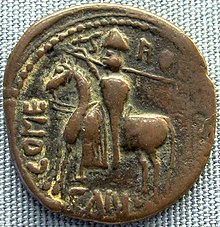
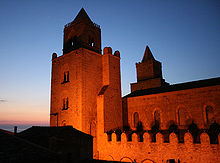
In 1038, seventy years after losing their last cities in Sicily, the Byzantines under the Greek generalGeorge Maniakesinvaded the island together with theirVarangianandNormanmercenaries. Maniakes was killed in a Byzantine civil war in 1043 before completing a reconquest and the Byzantines withdrew. Later the Normans invaded in 1061 and after takingApuliaandCalabria,Roger IoccupiedMessinawith an army of 700 knights.[58][62]In 1068, Roger I was victorious atMisilmeri.Most crucial was the siege of Palermo, whose fall in 1071 eventually resulted in all Sicily coming under Norman control.[63]The conquest was completed in 1091 when they capturedNotothe last Arab stronghold. Palermo continued to be the capital under theNormans.The Normans formed a small but violent ruling class. They destroyed many of the Arab towns in Sicily, and very few physical remains survive from the Arab era.[58]
The NormanHauteville family,appreciated and admired the rich and layered culture in which they now found themselves. They also introduced into Sicily their own culture, customs, and politics fromNormandy.Many Normans in Sicily adopted the habits and comportment of Muslim rulers and their Byzantine subjects in dress, language, literature, even to the extent of having palaceeunuchsand, according to some accounts, a harem.[64][65]

While Roger I died in 1101, his wifeAdelaideruled until 1112 when their sonRoger II of Sicilycame of age.[62]Having succeeded his brotherSimonas Count of Sicily, Roger II was ultimately able to raise the status of the island to a kingdom in 1130, along with his other holdings, which included theMaltese Islandsand the Duchies ofApuliaandCalabria.[63][66]
Roger II appointed the powerful GreekGeorge of Antiochto be his "emir of emirs" and continued the syncretism of his father. During this period, the Kingdom of Sicily was prosperous and politically powerful, becoming one of the wealthiest states in all of Europe—even wealthier than theKingdom of England.[67]
The court of Roger II became the most luminous centre of culture in the Mediterranean, both from Europe and the Middle East, like the multi-ethnicCaliphate of Córdoba,then only just eclipsed. This attracted scholars, scientists, poets, artists, and artisans of all kinds. Laws were issued in the language of the community to whom they were addressed in Norman Sicily, at the time when the culture was still heavily Arab and Greek.[68][69]Governance was by rule of law which promoted justice. Muslims, Jews,Byzantine Greeks,Lombards, and Normans worked together fairly amicably. During this time many extraordinary buildings were constructed.[68]
However this situation changed as the Normans imported immigrants fromNormandy,England,Lombardy, Piedmont, Provence andCampaniato secure the island. Linguistically, the island shifted from being one-third Greek- and two-thirds Arabic-speaking at the time of the Norman conquest to becoming fullyLatinised.[69]In terms of religion the island became completely Roman Catholic (bearing in mind that until 1054 the Churches owing allegiance to the Pope and the Patriarch of Constantinople belonged to one Church); Sicily before the Norman conquest was under the Eastern Orthodox Patriarch.[70]After Pope Innocent III made him Papal Legate in 1098, Roger I created several Catholic bishoprics while still allowing the construction of 12 Greek-speaking monasteries (the Greek language, monasteries, and 1500 parishes continued to exist until the adherents of the Greek Rite were forced in 1585 to convert to Catholicism or leave; a small pocket of Greek-speakers still live in Messina).
Kingdom of Sicily (1198–1860)
[edit]
After a century, the NormanHautevilledynasty died out; the last direct descendant and heir of Roger II,Constance,marriedEmperor Henry VI.[71]This eventually led to the crown of Sicily being passed to theHohenstaufendynasty, who were Germans fromSwabia.The last of the Hohenstaufens,Frederick II,the only son ofConstance,was one of the greatest and most cultured men of the Middle Ages. His mother's will had askedPope Innocent IIIto undertake the guardianship of her son. Frederick was four when atPalermo,he was crownedKing of Sicilyin 1198. Frederick received no systematic education and was allowed to run free in the streets ofPalermo.There he picked up the many languages he heard spoken, such as Arabic and Greek, and learned some of the lore of the Jewish community. At age twelve, he dismissed Innocent's deputy regent and took over the government; at fifteen he marriedConstance of Aragon,and began his reclamation of the imperial crown. Subsequently, due to Muslim rebellions, Frederick II destroyed the remaining Muslim presence in Sicily, estimated at 60,000 people, moving all to the city of Lucera in Apulia between 1221 and 1226.[72]
Conflict between the Hohenstaufen house and thePapacyled, in 1266, toPope Innocent IVcrowning theFrench princeCharles,count of AnjouandProvence,as the king of both Sicily and Naples.[71]

Strong opposition to French officialdom due to mistreatment and taxation saw the local peoples of Sicily rise up, leading in 1282 to aninsurrectionknown as theWar of the Sicilian Vespers,which eventually saw almost the entire French population on the island killed.[71]During the war, the Sicilians turned toPeter III of Aragon,son-in-law of the last Hohenstaufen king, for support after being rejected by the Pope. Peter gained control of Sicily from the French, who, however, retained control of theKingdom of Naples.A crusade was launched in August 1283 against Peter III and the Crown of Aragon byPope Martin IV(a pope fromÎle-de-France), but it failed. The wars continued until thepeace of Caltabellottain 1302, which saw Peter's sonFrederick IIIrecognized as the king of the Isle of Sicily, whileCharles IIwas recognized as the king of Naples byPope Boniface VIII.[71]Sicily was ruled as an independent kingdom by relatives of the kings of Aragon until 1409 and then as part of theCrown of Aragon.[36]
In October 1347, in Messina, Sicily, theBlack Deathfirst arrived in Europe.[73]
Between the 15th and 18th centuries, waves ofGreeksfrom thePeloponnese(such as theManiots) andArvanitesmigrated to Sicily in large numbers to escape persecution after theOttoman conquest of the Peloponnese.They brought with themEastern Orthodoxyas well as theGreekandArvanitikalanguages, once again adding onto the extensiveByzantine/Greekinfluence.[citation needed]

The onset of theSpanish Inquisitionin 1492 led toFerdinand IIdecreeing the expulsion of all Jews from Sicily.[71]The eastern part of the island was hit by destructive earthquakes in 1542 and 1693. Just a few years before the latter earthquake, the island was struck by aplague.[71]Theearthquake in 1693took an estimated 60,000 lives.[74]There were revolts during the 17th century, but these were quelled with force, especially the revolts of Palermo and Messina.[36]North Africanslave raidsdiscouraged settlement along the coast until the 19th century.[75][76]TheTreaty of Utrechtin 1713 saw Sicily assigned to theHouse of Savoy;however, this period of rule lasted only seven years, as it was exchanged for the island ofSardiniawithEmperor Charles VIof the AustrianHabsburg Dynasty.[77]
While the Austrians were concerned with theWar of the Polish Succession,aBourbonprince,Charlesfrom Spain was able to conquer Sicily and Naples.[78]At first Sicily was able to remain as an independent kingdom underpersonal union,while the Bourbons ruled over both from Naples. However, the advent ofNapoleon'sFirst French Empiresaw Naples taken at theBattle of Campo Teneseand BonapartistKing of Napleswas installed.Ferdinand III,the Bourbon, was forced to retreat to Sicily which he was still in control of with the help ofBritish navalprotection.[79]
Following this, Sicily joined theNapoleonic Wars,and subsequently the British underLord William Bentinckestablished a military and diplomatic presence on the island to protect against a French invasion. After the wars were won, Sicily and Naples formally merged as theTwo Siciliesunder the Bourbons. Majorrevolutionarymovements occurred in 1820 and 1848 against the Bourbon government with Sicily seeking independence; the second of which, the1848 revolutionresulted in a short period of independence for Sicily. However, in 1849 the Bourbons retook control of the island and dominated it until 1860.[80]
Italian unification
[edit]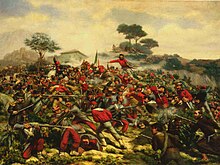
TheExpedition of the Thousandled byGiuseppe Garibaldicaptured Sicily in 1860, as part of theRisorgimento.[81]The conquest started atMarsala,and native Sicilians joined him in the capture of the southern Italian peninsula. Garibaldi's march was completed with thesiege of Gaeta,where the finalBourbonswere expelled and Garibaldi announced his dictatorship in the name ofVictor Emmanuel IIofKingdom of Sardinia.[82]Sicily became part of the Kingdom of Sardinia after a referendum in which more than 75% of Sicily voted in favour of the annexation on 21 October 1860 (although not everyone was allowed to vote). As a result of theproclamation of the Kingdom of Italy,Sicily became part of the kingdom on 17 March 1861.
The Sicilian economy (and the widermezzogiornoeconomy) remained relatively underdeveloped after theItalian unification,in spite of the strong investments made by theKingdom of Italyin terms of modern infrastructure, and this caused an unprecedentedwave of emigration.[81]In 1894, organisations of workers and peasants known as theFasci Sicilianiprotested against the bad social and economic conditions of the island, but they were suppressed in a few days.[83][84]TheMessina earthquakeof 28 December 1908 killed more than 80,000 people.[85]
This period was also characterized by the first contact between theSicilian mafia(the crime syndicate also known as Cosa Nostra) and the Italian government. The Mafia's origins are still uncertain, but it is generally accepted that it emerged in the 18th century initially in the role of private enforcers hired to protect the property of landowners and merchants from the groups ofbrigands(briganti) who frequently pillaged the countryside and towns. The battle against the Mafia made by the Kingdom of Italy was controversial and ambiguous. TheCarabinieri(the military police of Italy) and sometimes theItalian armywere often involved in fights against the mafia members, but their efforts were frequently useless because of the secret cooperation between the mafia and local government and also because of the weakness of the Italian judicial system.[86]
20th and 21st centuries
[edit]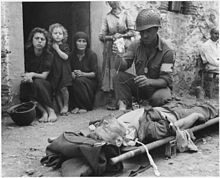
In the 1920s, theFascistregime began a stronger military action against the Mafia, which was led byprefectCesare Mori,who was known as the "Iron Prefect" because of his iron-fisted campaigns. This was the first time in which an operation against the Sicilian mafia ended with considerable success.[81]There was anAllied invasion of Sicilyduring World War II starting on 10 July 1943. In preparation for the invasion, the Alliesrevitalisedthe Mafia to aid them. The invasion of Sicily contributed to the25 July crisis;in general, the Allied victors were warmly embraced by Sicily.[87]
Italybecame a Republicin 1946 and, as part of theConstitution of Italy,Sicily was one of the fiveregionsgiven special status as anautonomous region.[88]Both the partial Italianland reformand special funding from the Italian government'sCassa per il Mezzogiorno(Fund for the South) from 1950 to 1984 helped the Sicilian economy. During this period, the economic and social condition of the island was generally improved due to investments in infrastructure such asmotorwaysandairports,and thanks to the creation of industrial and commercial areas.[89]In the 1980s, the Mafia was weakened by another campaign led by magistratesGiovanni FalconeandPaolo Borsellino.[90]Between 1990 and 2005, theunemployment ratefell from about 23% to 11%.[91][92]
The Cosa Nostra has traditionally been the most powerful group in Sicily, especially around Palermo.[93]A police investigation in summer 2019 also confirmed strong links between the Palermo areaSicilian Mafiaand American organized crime, particularly theGambino crime family.[94]According toLa Repubblica,"Off they go, through the streets of Passo di Rigano, Boccadifalco, Torretta and at the same time, Brooklyn, Staten Island, [and] New Jersey. Because from Sicily to the US, the old mafia has returned".[95]
Demographics
[edit]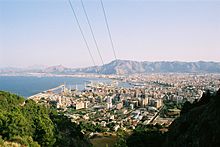
| Year | Pop. | ±% |
|---|---|---|
| 1861 | 2,409,000 | — |
| 1871 | 2,590,000 | +7.5% |
| 1881 | 2,933,000 | +13.2% |
| 1901 | 3,568,000 | +21.7% |
| 1911 | 3,812,000 | +6.8% |
| 1921 | 4,223,000 | +10.8% |
| 1931 | 3,906,000 | −7.5% |
| 1936 | 4,000,000 | +2.4% |
| 1951 | 4,486,749 | +12.2% |
| 1961 | 4,721,001 | +5.2% |
| 1971 | 4,680,715 | −0.9% |
| 1981 | 4,906,878 | +4.8% |
| 1991 | 4,966,386 | +1.2% |
| 2001 | 4,968,991 | +0.1% |
| 2011 | 5,002,904 | +0.7% |
| 2021 | 4,833,329 | −3.4% |
| Source:ISTAT | ||
About five million people live in Sicily, making it thefourth most populated region in Italy.In the first century after theItalian unification,Sicily had one of the most negativenet migration ratesamong the regions of Italy because of the emigration of millions of people to Northern Italy, other European countries, North America, South America and Australia. Like the South of Italy and Sardinia, immigration to the island is very low compared to other regions of Italy because workers tend to head toNorthern Italyinstead, due to better employment and industrial opportunities. According toISTATfigures from 2017,[96]show around 175,000 immigrants out of the total 5,029,615 population;[97]Romanianswith more than 50,000 make up the most immigrants, followed byTunisians,Moroccans,Sri Lankans,Albanians,and others mostly from Eastern Europe.[failed verification]As of 31 December 2020, there were 186,195 foreigners resident in the region.[98] As in the rest of Italy, the official language is Italian and the primary religion isRoman Catholicism.[99][100]
Emigration
[edit]
Sicilian emigration started shortly after theItalian unificationand has not stopped ever since.[101][citation needed].After theItalian unification,Sicily, along with the entire Italian peninsula, has also been strongly marked byeconomic emigration.Most of the assets of theKingdom of the Two Sicilies's former national bank,Banco delle Due Sicilie,were transferred to Piedmont.[102]During the first decades of c, a rising number of southern Italian manufactories were driven into ruin due to high taxation imposed by the central government.[citation needed]
The aforementioned factors, along with a failed land reform, resulted in a never-before-seen wave of Sicilians emigrating, first to theUnited Statesbetween the 1880s and the 1920s, later to Northern Italy, and from the 1960s onwards also toBelgium,France,Germany,Switzerland,as well asAustraliaandSouth America.
Today, Sicily is the Italian region with the highest number ofexpatriates:as of 2017, 750,000 Sicilians, 14.4% of the island's population, lived abroad.[103]For lack of employment, every year many Sicilians, especially young graduates, still leave the island to seek jobs abroad.[104]Today, an estimated 10 million people of Sicilian origins live around the world.
Largest cities
[edit]These are the ten largest cities of Sicily:[105]
| Rank | Name | Pop. (2017) | Area (km2) | Pop. per km2 |
|---|---|---|---|---|
| 1 | Palermo | 668,405 | 159 | 4,207 |
| 2 | Catania | 311,620 | 181 | 1,723 |
| 3 | Messina | 234,293 | 212 | 1,107 |
| 4 | Syracuse | 121,605 | 204 | 596 |
| 5 | Marsala | 82,802 | 242 | 343 |
| 6 | Gela | 74,858 | 277 | 270 |
| 7 | Ragusa | 73,638 | 442 | 166 |
| 8 | Trapani | 67,923 | 272 | 250 |
| 9 | Vittoria | 64,212 | 181 | 354 |
| 10 | Caltanissetta | 62,317 | 416 | 150 |
Religion
[edit]
As in most Italian regions,Roman Catholicismis the predominant religious denomination in Sicily, and the church still plays an important role in the lives of most people. There is also a notable small minority of Eastern-riteByzantine Catholicswhich has a mixed congregation of ethnicAlbanians;it is operated by theItalo-Albanian Catholic Church.Most people still attend church weekly or at least for religious festivals, and many people get married in churches. There was a wide presence of Jews in Sicily for at least 1,400 years and possibly for more than 2,000 years. Some scholars believe that the Sicilian Jewry are partial ancestors of theAshkenazi Jews.[106]However, much of the Jewish community faded away when they wereexpelled from the islandin 1492.Islamwas present during theEmirate of Sicily,although Muslims were also expelled. Today, mostly due to immigration to the island, there are also several religious minorities, such as Jehovah's Witnesses,Hinduism,Islam, Judaism, andSikhism.There are also a someEvangelical Christianswho live on the island. As of 2020, there are approximately 4,989,921 Roman Catholics in Sicily constituting about 99.2% of the island's population. Additionally there are also about 23,120 members of theItalo-Albanian Catholic Churchalso living in Sicily constituting roughly 0.5% of the population.[107]
Politics
[edit]The politics of Sicily takes place in a framework of apresidentialrepresentative democracy,whereby the President of Regional Government is thehead of government,and of a pluriformmulti-party system.Executive poweris exercised by the Regional Government.Legislative poweris vested in both the government and theSicilian Regional Assembly.The capital of Sicily isPalermo.
Traditionally, Sicily votes for centre-right parties during elections.[108]From 1943 to 1951, there was also aseparatistpolitical party calledSicilian Independence Movement(Movimento Indipendentista Siciliano,MIS). Their most successful result was at the1946 general election,when MIS obtained 0.7% of national votes (8.8% of votes in Sicily), and four seats. However, the movement lost all their seats following the1948 general electionand the 1951 regional election. Even though it has never been formally disbanded, today the movement is no longer part of thepolitics of Sicily.AfterWorld War II,Sicily became a stronghold of theChristian Democracy,in opposition to theItalian Communist Party.TheCommunistsand their successors (theDemocratic Party of the Left,theDemocrats of the Leftand the present-dayDemocratic Party) had never won any seats in the region until2012.Sicily is now governed by a centre-right coalition.Renato Schifaniis the current President and has served since 2022.
Administrative divisions
[edit]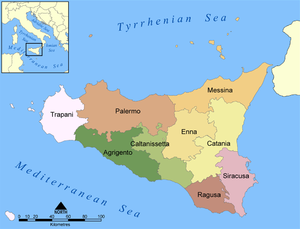
Administratively, Sicily is divided into nine provinces, each with a capital city of the same name as the province. Small surrounding islands are also part of various Sicilian provinces: theAeolian Islands(Messina), isle ofUstica(Palermo),Aegadian Islands(Trapani), isle ofPantelleria(Trapani) andPelagian Islands(Agrigento).
| Province | Area (km2) |
Population[109] | Density (Pop. per km2) |
Number of communes |
|---|---|---|---|---|
| Agrigento | 3,042 | 453,594 | 149.1 | 43 |
| Caltanissetta | 2,128 | 271,168 | 127.4 | 22 |
| Catania | 3,552 | 1,090,620 | 307.0 | 58 |
| Enna | 2,562 | 172,159 | 67.2 | 20 |
| Messina | 3,247 | 652,742 | 201.0 | 108 |
| Palermo | 4,992 | 1,249,744 | 250.3 | 82 |
| Ragusa | 1,614 | 318,980 | 197.6 | 12 |
| Siracusa | 2,109 | 403,559 | 191.3 | 21 |
| Trapani | 2,460 | 436,240 | 177.3 | 24 |
Economy
[edit]
Thanks to regular growth in recent years, Sicily is the eighth largest regional economy of Italy in terms of total GDP (seeList of Italian regions by GDP). A series of reforms and investments in agriculture, such as the introduction of modern irrigation systems, has made this important industry competitive.[110]In the 1970s, some factories were opened, resulting in growth in theindustrial sector.[111]In recent years theservice industryhas become more important due to the opening of several shopping malls and some modest growth in financial and telecommunication activities.[112]Tourism is an important source of income for the island, which attracts visitors due to its rich natural and historical heritage. Today Sicily is investing a large amount of money into the development of itshospitality industry,to attract even more tourism.[113]However, Sicily continues to have a GDP per capita below the Italian average, and higher unemployment than the rest of Italy.[114]
Agriculture
[edit]
Sicily has long been noted for its fertile soil, which is the result of past volcanic eruptions. The local agriculture is also helped by the pleasant climate of the island. The main agricultural products are wheat,citrons,oranges(Arancia Rossa di Sicilia IGP),lemons, tomatoes(Pomodoro di Pachino IGP),olives,olive oil,artichokes,prickly pear(Fico d'India dell'EtnaDOP),almonds,grapes,pistachios(Pistacchio diBronteDOP)and wine. Cattle and sheep are raised. The production of cheese is particularly important thanks to theRagusano DOPand thePecorino Siciliano DOP.Ragusais noted for itshoney(Miele Ibleo) and chocolate (Cioccolato di ModicaIGP) products.[115][116][117][118][119]
Sicily is the third largest wine producer in Italy, afterVenetoandEmilia Romagna(and Italy is the world's largest wine producer).[120]The region is known mainly for fortifiedMarsala wines.In recent decades the wine industry has improved, new winemakers are experimenting with less-well-known native varieties, and Sicilian wines have become better known.[121]The best known local variety isNero d'Avolanamed afterAvola,a town not far fromSyracuse.Other important native varieties are:Nerello Mascalese,used to make theEtna Rosso DOC wine;Frappato,a component of theCerasuolo di Vittoria DOCG wine;Moscato di Pantelleria(also known asZibibbo), which is used to make differentPantelleriawines;Malvasia di Lipari,used for theMalvasia di Lipari DOC wine;andCatarratto,mostly used to make a white wine,Alcamo DOC.Furthermore, in Sicily, high-quality wines are also produced using non-native varieties likeSyrah,ChardonnayandMerlot.[122]
Sicily is also known for its liqueurs, such asAmaro Averna,produced inCaltanissetta,and the locallimoncello.
Fishing is another fundamental resource for Sicily. It has importanttuna,sardine,swordfishandEuropean anchovyfisheries.Mazara del Vallois the largest fishing centre in Sicily and one of the most important in Italy.[123]
Industry and manufacturing
[edit]

Improvements in Sicily's road system have helped to promote industrial development. The region has three importantindustrial districts:
- CataniaIndustrial District,where there are severalfood industriesand one of the best Europeanelectronics industrycentres calledEtna Valley(in honour of the best knownSilicon Valley) which contains offices and factories of international companies such asSTMicroelectronicsandNumonyx;[123][124]
- SyracusePetrochemical Districtwithchemical industries,oil refineriesand importantpower stations(as the innovativeArchimede combined cycle power plant);[125]
- the latestEnnaIndustrial Districtin which there arefood industries.[126]
InPalermothere are importantshipyards(such asFincantieri),mechanicalfactories of famous Italian companies asAnsaldo Breda,publishing and textile industries.Chemical industriesare also in theProvince of Messina(Milazzo) and in theProvince of Caltanissetta(Gela).[118] There are petroleum, natural gas andasphaltfields in the Southeast (mostly nearRagusa) and massive deposits ofhalitein Central Sicily.[127]TheProvince of Trapaniis one of the largestsea saltproducers in Italy.[128]
Statistics
[edit]GDP growth
[edit]Sicily's GDP (nominal and per capita) growth between 2000 and 2008 was as follows:[129][130]
| 2000 | 2001 | 2002 | 2003 | 2004 | 2005 | 2006 | 2008 | |
|---|---|---|---|---|---|---|---|---|
| Gross Domestic Product (Millions of Euros) |
67,204 | 70,530 | 72,855 | 75,085 | 77,327 | 80,358 | 82,938 | 88,328 |
| GDP (PPP) per capita (Euro) |
13,479 | 14,185 | 14,662 | 15,053 | 15,440 | 16,023 | 16,531 | 17,533 |
Economic sectors
[edit]Sectors of the Sicilian economy in 2006:
| Economic activity | GDP € millions |
% sector (Sicily) |
% sector (Italy) |
|---|---|---|---|
| Agriculture, farming, fishing | 2,923.3 | 3.52% | 1.84% |
| Industry | 7,712.9 | 9.30% | 18.30% |
| Constructions | 4,582.1 | 5.52% | 5.41% |
| Commerce, hotels and restaurants, transport, services and (tele)communications | 15,159.7 | 18.28% | 20.54% |
| Financial activity and real estate | 17,656.1 | 21.29% | 24.17% |
| Other economic activities | 24,011.5 | 28.95% | 18.97% |
| VAT and other forms of taxes | 10,893.1 | 13.13% | 10.76% |
| GDP of Sicily | 82,938.6 |
Unemployment rate
[edit]The unemployment rate was 21.5% in 2018 and was one of the highest in Italy and Europe.[131][132]
| Year | 2006 | 2007 | 2008 | 2009 | 2010 | 2011 | 2012 | 2013 | 2014 | 2015 | 2016 | 2017 | 2018 |
|---|---|---|---|---|---|---|---|---|---|---|---|---|---|
| Unemployment rate | 13.4% | 12.9% | 13.7% | 13.8% | 14.6% | 14.3% | 18.4% | 21.0% | 22.2% | 21.4% | 22.1% | 21.5% | 21.5% |
Transport
[edit]Roads
[edit]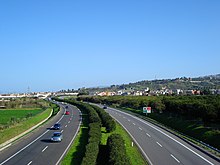

Highways have been built and expanded in the last four decades. The most prominent Sicilian roads are the motorways (known asautostrade) in the north of the island. Much of the motorway network is elevated on pillars due to the island's mountainous terrain.[133][134][135][136]Other main roads in Sicily are theStrade Statali,such as the SS.113 that connectsTrapanito Messina (via Palermo), the SS.114 Messina-Syracuse(via Catania) and the SS.115 Syracuse-Trapani (viaRagusa,GelaandAgrigento).
| Sign | Motorway | Length | Toll | Services |
|---|---|---|---|---|
| A18 Messina-Catania | 76 km (47 mi) | |||
| RA15 Catania's Bypass (West) | 24 km (15 mi) | Free | ||
| Motorway Catania-Siracusa | 25 km (16 mi) | Free | No | |
| A18 Siracusa-Rosolini | 40 km (25 mi) | Free | No | |
| A19 Palermo-Catania | 199 km (124 mi) | Free | ||
| A20 Palermo-Messina | 181 km (112 mi) | |||
| A29 Palermo-Mazara del Vallo | 119 km (74 mi) | Free | No | |
| A29dir Alcamo-Trapani/Marsala | 38 km (24 mi) and 44 km (27 mi) |
Free | No |
Railways
[edit]


The first railway in Sicily was opened in 1863 (Palermo-Bagheria) and today all of the Sicilian provinces are served by a network of railway services, linking to most major cities and towns; this service is operated byTrenitalia.Of the 1,378 km (856 mi) of railway tracks in use, over 60% has beenelectrifiedwhilst the remaining 583 km (362 mi) are serviced bydieselengines. 88% of the lines (1.209 km) are single-track and only 169 km (105 mi) are double-track serving the two main routes, Messina-Palermo (Tyrrhenian) and Messina-Catania-Syracuse (Ionian), which are the main lines of this region. Of thenarrow-gauge railwaystheFerrovia Circumetneais the only one that still operates, going roundMount Etna.From the major cities of Sicily, there are services toNaples,RomeandMilan;this is achieved by the trains being loaded ontoferrieswhich cross the Strait.[137]
InCataniathere is anunderground railwayservice (metropolitana di Catania); inPalermothe national railway operatorTrenitaliaoperates acommuter rail(Palermo metropolitan railway service), the Sicilian Capital is also served by 4 AMAT (Comunal Public Transport Operator) tramlines;Messinais served by atramline.
Airports
[edit]
Sicily has several airports that serve numerous Italian and European destinations and some extra-European.
- Catania-Fontanarossa Airport,located on the east coast, is the busiest on the island (and one of the busiest in all of Italy).
- Palermo International Airport,which is also a substantially large airport with many national and international flights.
- Trapani-Birgi Airport,a military-civil joint-use airport (third for traffic on the island). Recently the airport has seen an increase in traffic thanks to alow-cost carrier.
- Comiso-Ragusa Airport,has recently been refurbished and re-converted from military use to a civil airport. It was opened to commercial traffic and general aviation on 30 May 2013.
- Palermo-Boccadifalco Airportis the old airport of Palermo and is currently used forgeneral aviationand as a base for theGuardia di Finanzaandpolice helicopters.
- NAS Sigonella Airport,it is an Italian Air Force and US Navy installation.
- Lampedusa Airport.
- Pantelleria Airport.
Ports
[edit]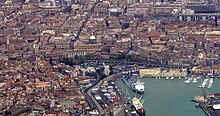
By sea, Sicily is served by several ferry routes and cargo ports, and in all major cities, cruise ships dock on a regular basis.
- Mainland Italy: Ports connecting to the mainland areMessina(route toVilla San GiovanniandSalerno), the busiest passenger port in Italy,Palermo(routes toGenoa,CivitavecchiaandNaples) andCatania(route toNaples).
- Sicily's small surrounding islands: The port ofMilazzoserves theAeolian Islands,the ports ofTrapaniandMarsalatheAegadian Islandsand the port ofPorto EmpedoclethePelagie Islands.From Palermo there is a service to the island ofUsticaand toSardinia.
- International connections: From Palermo and Trapani there are weekly services toTunisiaand there is also a daily service betweenMaltaandPozzallo.[138][139]
- Commercial and cargo ports: The port ofAugustais the fifth-largest cargo port in Italy and handles tonnes of goods. Other major cargo ports are Palermo, Catania, Trapani,PozzalloandTermini Imerese.
- Touristic ports: Several ports along the Sicilian coast are in the service of private boats that need to moor on the island. The main ports for this traffic are inMarina di Ragusa,Riposto,Portorosa,Syracuse,CefalùandSciacca.In Sicily, Palermo is also a major centre for boat rental, with or without crew, in the Mediterranean.
- Fishing ports: Like all islands, Sicily also has many fishing ports. The most important is inMazara del Vallofollowed byCastellamare del Golfo,Licata,ScoglittiandPortopalo di Capo Passero.
Planned bridge
[edit]Plans for a bridge linking Sicily to the mainland have been discussed since 1865. Throughout the last decade, plans were developed for a road and rail link to the mainland via what would be the world's longestsuspension bridge,theStrait of Messina Bridge.Planning for the project has experienced several false starts over the past few decades. On 6 March 2009,Silvio Berlusconi's government declared that the construction works for the Messina Bridge would begin on 23 December 2009, and announced a pledge of €1.3 billion as a contribution to the bridge's total cost, estimated at €6.1 billion.[140] The plan has been criticized by environmental associations and some local Sicilians and Calabrians, concerned with its environmental impact, economic sustainability and even possible infiltrations by organized crime.[141][142]
Tourism
[edit]
Sicily's sunny, dry climate, scenery, cuisine, history, and architecture attract many tourists from the rest of Italy and abroad. The tourist season peaks in the summer months, although people visit the island all year round.Mount Etna,the beaches, the archaeological sites, and major cities such asPalermo,Catania,SyracuseandRagusaare the favourite tourist destinations, but the old town ofTaorminaand the neighbouring seaside resort ofGiardini Naxosdraw visitors from all over the world, as do theAeolian Islands,Erice,Terrasini,Castellammare del Golfo,Cefalù,Agrigento,thePelagie IslandsandCapo d'Orlando.The last features some of the best-preserved temples of the ancient Greek period. Many Mediterranean cruise ships stop in Sicily, and many wine tourists also visit the island.
Some scenes of several Hollywood andCinecittàfilms were shot in Sicily. This increased the attraction of Sicily as a tourist destination.[143]
UNESCO World Heritage Sites
[edit]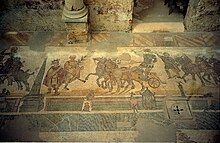
There are sevenUNESCO World Heritage Siteson Sicily. By the order of inscription:
- Valle dei Templi(1997) is one of the most outstanding examples ofMagna Graeciaart and architecture, and is one of the main attractions of Sicily as well as a national monument of Italy. The site is located inAgrigento.[144]
- Villa Romana del Casale(1997) is aRoman villabuilt in the first quarter of the 4th century and located about 3 km (2 mi) outside the town ofPiazza Armerina.It contains the richest, largest and most complex collection of Roman mosaics in the world.[145]
- Aeolian Islands(2000) are avolcanicarchipelagoin theTyrrhenian Sea,named after the demigod of the windsAeolus.The Aeolian Islands are a tourist destination in the summer, and attract up to 200,000 visitors annually.[146]
- Late Baroque Towns of the Val di Noto(2002) "represent the culmination and final flowering ofBaroqueart in Europe ".[147]It includes several towns:Caltagirone,Militello in Val di Catania,Catania,Modica,Noto,Palazzolo Acreide,RagusaandScicli.
- Necropolis of Pantalica(2005) is a largeNecropolisin Sicily with over 5,000 tombs dating from the 13th to the 7th centuries BC.Syracuseis notable for its rich Greek history, culture, amphitheatres and architecture. They are situated in south-eastern Sicily.
- Mount Etna(2013) is one of the most active volcanoes in the world and is in an almost constant state of activity and generated myths, legends and naturalistic observation from Greek, Celts and Roman classic and medieval times.[148]
- Arab-NormanPalermoand the cathedral churches ofCefalùandMonreale;includes a series of nine civil and religious structures dating from the era of the Norman kingdom of Sicily (1130–1194)[149]

Tentative UNESCO World Heritage sites
[edit]
- Taorminaand Isola Bella;[150]
- MotyaandLibeo Island:The Phoenician-Punic Civilisation in Italy;[151]
- Scala dei Turchi;[152]
- Strait of Messina.[153]
Archeological sites
[edit]Because many different cultures settled, dominated or invaded the island, Sicily has a huge variety ofarchaeological sites.Also, some of the most notable and best preserved temples and other structures of the Greek world are located in Sicily.[154]Here is a short list of the major archaeological sites:
- Sicels/Sicans/Elymians/Greeks:Segesta,Eryx,Cava Ispica,Thapsos,Pantalica;
- Greeks:Syracuse,Agrigento,Segesta,Selinunte,Gela,Kamarina,Himera,Megara Hyblaea,Naxos,Heraclea Minoa;
- Phoenicians:Motya,Soluntum,Marsala,Palermo;
- Romans:Piazza Armerina,Centuripe,Taormina,Palermo;
The excavation and restoration of one of Sicily's best known archaeological sites, theValley of the Templesin Agrigento, was at the direction of the archaeologistDomenico Antonio Lo Faso Pietrasanta,Fifth Duke ofSerradifalco,known in archaeological circles simply as"Serradifalco".He also oversaw the restoration of ancient sites atSegesta,Selinunte,SiracusaandTaormina.
Castles
[edit]In Sicily there are hundreds of castles, the most relevant are:
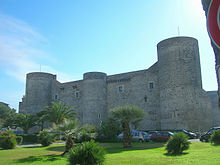


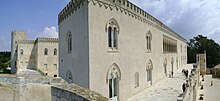
| Province | Castles | Commune |
|---|---|---|
| Caltanisetta | Castello Manfredonico | Mussomeli |
| U Cannuni | Mazzarino | |
| Castelluccio di Gela | Gela | |
| Catania | Castello Ursino | Catania |
| Castello Normanno | Adrano | |
| Castello Normanno | Paternò | |
| Castello di Aci | Aci Castello | |
| Enna | Castello di Lombardia | Enna |
| Messina | Forte dei Centri | Messina |
| Castello di Milazzo | Milazzo | |
| Castello di Federico II | Montalbano Elicona | |
| Castello di Sant'Alessio Siculo | Sant'Alessio Siculo | |
| Castello di Pentefur | Savoca | |
| Castello di Schisò | Giardini Naxos | |
| Palermo | Zisa, Palermo | Palermo |
| Castello di Caccamo | Caccamo | |
| Castello di Carini | Carini | |
| Castello dei Ventimiglia | Castelbuono | |
| Ragusa | Castello di Donnafugata | Ragusa |
| Torre Cabrera | Pozzallo | |
| Castello Dei Conti | Modica | |
| Syracuse | Castello Maniace | Syracuse |
| Castello Svevo | Augusta | |
| Trapani | Castello di Venere | Erice |
| Castle of the Counts of Modica | Alcamo | |
| Castle of Calatubo | Alcamo |
Coastal towers
[edit]The Coastal towers in Sicily (Torri costiere della Sicilia) are 218 oldwatchtowersalong the coast. In Sicily, the first coastal towers date back to the late Norman period. From 1360 the threat came from the south, fromNorth AfricatoMaghreb,mainly toBarbary piratesand corsairs ofBarbary Coast.In 1516, the Turks settled inAlgiers,and from 1520, the corsairHayreddin Barbarossaunder the command ofOttoman Empire,operated from that harbour.
Most existing towers were built on architectural designs of the Florentine architectCamillo Camillianifrom [1583] to 1584 and involved the coastal periple of Sicily. The typology changed completely in '800, because of the new higher fire volumes of cannon vessels, the towers were built on the type ofMartello towersthat the British built in the UK and elsewhere in the British Empire. The decline of Mediterranean piracy caused by theSecond Barbary Warled to a smaller number of coastal towers built during the 19th century.[155]
-
Torre-Capo-Rama (Terrasini)
-
Torre Normanna (Altavilla Milicia)
-
Torre Spalmatore (Ustica)
-
Torre Pozzillo (Cinisi)
-
Torre Nubia (Paceco)
Historical villages
[edit]Sicily has many small and picturesque villages, 24 of them have been selected byI Borghi più belli d'Italia(English:The most beautiful Villages of Italy),[156]a non-profit private association of small Italian towns of strong historical and artistic interest,[157]that was founded on the initiative of the Tourism Council of the National Association of Italian Municipalities.[158]
Culture
[edit]To have seen Italy without having seen Sicily is to not have seen Italy at all, for Sicily is the clue to everything.

Sicily has long been associated withthe arts;many poets, writers,philosophers,intellectuals, architects and painters have roots on the island. The history of prestige in this field can be traced back to Greek philosopherArchimedes,aSyracusenative who has gone on to become renowned as one of the greatest mathematicians of all time.[160]GorgiasandEmpedoclesare two other highly noted early Sicilian-Greek philosophers, while the Syracusan-GreekEpicharmusis held to be the inventor of comedy.[161][162]
Art and architecture
[edit]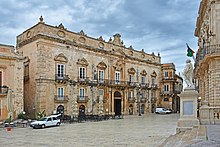
Baglio are traditional living structures in Western Sicily.
Ceramics
[edit]Terracottaceramicsfrom the island are well known, the art of ceramics on Sicily goes back to the original ancient peoples named theSicanians,it was then perfected during the period of Greek colonisation and is still prominent and distinct to this day.[163]Nowadays,Caltagironeis one of the most important centres in Sicily for the artistic production of ceramics and terra-cotta sculptures. Famous painters includeRenaissanceartistAntonello da Messina,Pietro Novelli,Bruno Caruso,Renato Guttusoand Greek bornGiorgio de Chiricowho is commonly dubbed the "father ofSurrealist art"and founder of themetaphysical artmovement.[164]The most noted architects areFilippo Juvarra(one of the most important figures of the ItalianBaroque) andErnesto Basile.
Sicilian Baroque
[edit]
TheSicilian Baroquehas a unique architectural identity.Noto,Caltagirone,Catania,Ragusa,Modica,Scicliand particularlyAcirealecontain some of Italy's best examples ofBaroque architecture,carved in the local redsandstone.Noto provides one of the best examples of the Baroque architecture brought to Sicily. The Baroque style in Sicily was largely confined to buildings erected by the church, andpalazzibuilt as private residences for the Sicilian aristocracy.[165]The earliest examples of this style in Sicily lacked individuality and were typically heavy-handed pastiches of buildings seen by Sicilian visitors to Rome,Florence,andNaples.However, even at this early stage, provincial architects had begun to incorporate certain vernacular features of Sicily's older architecture. By the middle of the 18th century, when Sicily's Baroque architecture was noticeably different from that of the mainland, it has a unique freedom of design that is difficult to characterize in words.
Music and film
[edit]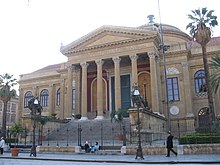
Palermohosts theTeatro Massimowhich is the largestopera housein Italy and the third largest in all of Europe.[166] InCataniathere is another importantopera house,theTeatro Massimo Belliniwith 1,200 seats, which is considered one of the best Europeanopera housesfor its acoustics. Sicily's composers vary fromVincenzo Bellini,Sigismondo d'India,Giovanni PaciniandAlessandro Scarlatti,to contemporary composers such asSalvatore SciarrinoandSilvio Amato.


Many award-winning and acclaimed films of Italian cinema have been filmed in Sicily, amongst the most noted of which are:Visconti's"La Terra Trema"and"Il Gattopardo",Pietro Germi's"Divorzio all'Italiana"and"Sedotta e Abbandonata",Tornatore's"Cinema Paradiso".
The annualTaormina Film Festtakes places inTaormina.
Literature
[edit]
The golden age of Sicilian poetry began in the early 13th century with theSicilian SchoolofGiacomo da Lentini,which was highly influential onItalian literature.Some of the most noted figures among writers and poets areLuigi Pirandello(Nobel laureate, 1934),Salvatore Quasimodo(Nobel laureate, 1959),Giovanni Verga(the father of theItalianVerismo),Domenico Tempio,Giovanni Meli,Luigi Capuana,Mario Rapisardi,Federico de Roberto,Leonardo Sciascia,Vitaliano Brancati,Giuseppe Tomasi di Lampedusa,Elio Vittorini,Vincenzo ConsoloandAndrea Camilleri(noted for his novels and short stories with the fictional characterInspector Salvo Montalbanoas protagonist). On the political side notable philosophers includeGaetano MoscaandGiovanni Gentilewho wroteThe Doctrine of Fascism.
Languages
[edit]Today, in Sicily, most people are bilingual and speak bothItalianandSicilian,aRomance languagedistinct from Italian. SomeSicilianwords areloanwordsfromGreek,Catalan,Norman,French,Arabic,Spanish and other languages.[167]Varieties related to Sicilian are also spoken inCalabriaandSalento.[168]Nowadays, the use ofSicilianis limited to informal contexts (mostly in family) and in a majority of cases it is replaced by the so-calledregional Italianof Sicily,a variety of Italian that is influenced by Sicilian.[169][170]Sicilian had a significant influence on theMaltese language.[171]
Sicilian was an early influence in the development of the first Italian standard, although its use remained confined to an intellectual elite. This was a literary language in Sicily created under the auspices ofFrederick IIand his court of notaries, orMagna Curia,which, headed byGiacomo da Lentini,also gave birth to theSicilian School,widely inspired bytroubadourliterature. Its linguistic and poetic heritage was later assimilated into the literary Florentine dialect use byDante Alighieri,the father of modern Italian. Dante, in hisDe vulgari eloquentia,claims that "In effect, this vernacular seems to deserve higher praise than the others since all the poetry written by Italians can be called Sicilian".[172]It is in this language that appeared the firstsonnet,whose invention is attributed to Giacomo da Lentini himself.
Other languages are spoken in Sicily. Within theprovince of Palermo,four towns are home to speakers ofArbërëshvarieties.[173]Arbërësh is the name given to varieties ofAlbanianspoken in Italy. In the eastern part of the island, there areGallo-Italicvarieties known asGallo-Italic of Sicily,[174][175]which are related to the other Gallo-Italic languages spoken in most of northern Italy and in other isolated pockets of southern Italy.
Science
[edit]Cataniahas one of the four laboratories of theIstituto Nazionale di Fisica Nucleare(National Institute for Nuclear Physics) in which there is acyclotronthat usesprotonsboth fornuclear physicsexperiments and for particle therapy to treat cancer (proton therapy).[176][177]Notohas one of the largestradio telescopesin Italy that performs geodetic and astronomical observations.[178]There areobservatoriesinPalermoandCatania,managed by theIstituto Nazionale di Astrofisica(National Institute for Astrophysics). In theObservatory of Palermothe astronomerGiuseppe Piazzidiscovered the first and the largestasteroidto be identifiedCeres(today considered adwarf planet) on 1 January 1801;[179]Cataniahas two observatories, one of which is situated onMount Etnaat 1,800 metres (5,900feet).[180]
Syracuseis also an experimental centre for solar technologies through the creation of the projectArchimede solar power plantthat is the firstconcentrated solar power plantto usemolten saltfor heat transfer and storage which is integrated with acombined-cyclegas facility. All the plant is owned and operated byEnel.[181][182]The touristic town ofEriceis also an important science place thanks to theEttore Majorana Foundation and Centre for Scientific Culturewhich embraces 123 schools from all over the world, covering all branches of science, offering courses, seminars, workshops, and annual meetings. It was founded by the physicistAntonino Zichichiin honour of another scientist of the island,Ettore Majoranaknown for theMajorana equationandMajorana fermions.[183]Sicily's famous scientists include alsoStanislao Cannizzaro(chemist),Giovanni Battista HodiernaandNiccolò Cacciatore(astronomers).

Education
[edit]Sicily has four universities:
- TheUniversity of Cataniadates back to 1434 and it is the oldest university in Sicily. It currently hosts 12 faculties and over 62,000 students and it offers undergraduate and postgraduate programs.Cataniahosts also theScuola Superiore,anacademic institutionlinked to the University of Catania, aiming for excellence in education.[184]
- TheUniversity of Palermois the island's second-oldest university. It was officially founded in 1806, although historical records indicate that medicine and law have been taught there since the late 15th century. TheOrto botanico di Palermo(Palermo botanical gardens) is home to the university's Department of Botany and is also open to visitors.
- TheUniversity of Messina,founded in 1548 byIgnatius of Loyola.It is organized in 11 Faculties.
- TheKore University of Ennafounded in 1995, is the latest Sicilian university and the first university founded in Sicily after theItalian Unification.
Cuisine
[edit]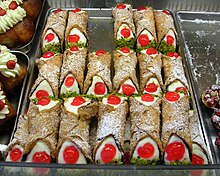
The island has a long history of producing a variety of noted cuisines and wines, to the extent that Sicily is sometimes nicknamedGod's Kitchenbecause of this.[185]Every part of Sicily has its speciality (e.g. Cassata is typical of Palermo although available everywhere in Sicily, as is Granita). The ingredients are typically rich in taste while remaining affordable to the general public.[186]The savoury dishes of Sicily are viewed to behealthy,using fresh vegetables and fruits, such as tomatoes,artichokes,olives(includingolive oil),citrus,apricots,aubergines,onions,beans,raisinscommonly coupled with seafood, freshly caught from the surrounding coastlines, includingtuna,sea bream,sea bass,cuttlefish,swordfish,sardines,and others.[187]
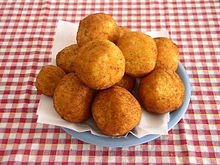
The most well-known part of Sicilian cuisine is the rich sweet dishes includingice creamsandpastries.Cannoli(singular:cannolo), a tube-shaped shell of fried pastry dough filled with a sweet filling usually containingricotta,is strongly associated with Sicily worldwide.[188]Biancomangiare, biscotti ennesi (cookies native toEnna), braccilatte (a Sicilian version ofdoughnuts),buccellato,ciarduna,pignoli,Biscotti Regina,giurgiulena,frutta martorana,cassata,pignolata,granita,cuccidati(a variety of fig cookie; also known as buccellati) andcuccìaare some notable sweet dishes.[188]
Like the cuisine of the rest of southern Italy, pasta plays an important part in Sicilian cuisine, as does rice; for example witharancini.[189]As well as using some other cheeses, Sicily has spawned some of its own, using both cow's and sheep's milk, such aspecorinoandcaciocavallo.[190]Spices used includesaffron,nutmeg,clove,pepper,andcinnamon,which were introduced by the Arabs.Parsleyis used abundantly in many dishes. Although Sicilian cuisine is commonly associated with sea food, meat dishes, includinggoose,lamb,goat, rabbit, andturkey,are also found in Sicily. It was theNormansandSwabianswho first introduced a fondness for meat dishes to the island.[191]Some varieties of wine are produced from vines that are relatively unique to the island, such as theNero d'Avolamade near the baroque town ofNoto.[192]
Sports
[edit]
The most popular sport in Sicily isfootball,which came to the fore in the late 19th century under the influence of the English. Some of the oldest football clubs in Italy are from Sicily: the three most successful arePalermo,Catania,andMessina,which have played 29, 17 and 5 seasons in theSerie Arespectively. No club from Sicily has ever won Serie A, but football is still deeply embedded in local culture and all over Sicily most towns have a representative team.[193]
Palermo and Catania have a heated rivalry and compete in theSicilian derbytogether. Palermo is the only team in Sicily to have played on the European stage, in theUEFA Cup.In the island, the most noted footballer isSalvatore Schillaci,who won theGolden Bootat the1990 FIFA World CupwithItaly.[193]Other noted players includeGiuseppe Furino,Pietro Anastasi,Francesco Coco,Christian Riganò,andRoberto Galia.[193]There have also been some noted managers from the island, such asCarmelo Di BellaandFranco Scoglio.
Although football is the most popular sport in Sicily, the island also has participants in other fields.Amatori Cataniahave competed in the top Italian nationalrugby unionleague calledNational Championship of Excellence.They have even participated at the European level in theEuropean Challenge Cup.Competing in the basketball variation ofSerie AisOrlandina BasketfromCapo d'Orlandoin theprovince of Messina,where the sport has a reasonable following. Various other sports that are played to some extent include volleyball,handball,andwater polo.Previously, inmotorsport,Sicily held the prominentTarga Floriosports car race that took place in the Madonie Mountains, with the start-finish line inCerda.[194]The event was started in 1906 by Sicilian industrialist and automobile enthusiastVincenzo Florio,and ran until it was canceled due to safety concerns in 1977.[194]
From 28 September to 9 October 2005Trapaniwas the location of Acts 8 and 9 of theLouis Vuitton Cup.This sailing race featured, among other entrants, all boats that took part in the 2007America's Cup.
Popular culture
[edit]

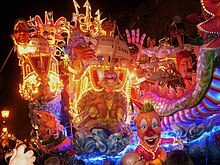
Each town and city has its own patron saint, and thefeast daysare marked by colourful processions through the streets with marching bands and displays of fireworks.
Sicilian religious festivals also include thepresepe vivente(livingnativity scene), which takes place at Christmas time. Deftly combining religion and folklore, it is a constructed mock 19th-century Sicilian village, complete with a nativity scene, and has people of all ages dressed in the costumes of the period, some impersonating the Holy Family, and others working as artisans of their particular assigned trade. It is normally concluded onEpiphany,often highlighted by the arrival of themagion horseback.
Oral tradition plays a large role in Sicilian folklore. Many stories passed down from generation to generation involve a character named "Giufà".Anecdotes from this character's life preserve Sicilian culture as well as convey moral messages.
Sicilians also enjoy outdoor festivals, held in the local square orpiazzawhere live music and dancing are performed on stage, and food fairs orsagreare set up in booths lining the square. These offer various local specialties, as well as typical Sicilian food. Normally these events are concluded with fireworks. A notedsagrais theSagra del CarciofoorArtichokeFestival,which is held annually inRamaccain April. The most important traditional event in Sicily is thecarnival.Famous carnivals are inAcireale,Misterbianco,Regalbuto,Paternò,Sciacca,Termini Imerese.
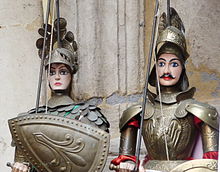
TheOpera dei Pupi(Opera of the Puppets;Sicilian:Òpira dî pupi) is amarionettetheatrical representation of Frankish romantic poems such as theSong of RolandorOrlando furiosothat is one of the characteristic cultural traditions of Sicily. The sides of donkey carts are decorated with intricate, painted scenes; these same tales are enacted in traditionalpuppet theatresfeaturing hand-made marionettes of wood. The opera of the puppets and the Sicilian tradition ofcantastorî(singers of tales) are rooted in the Provençaltroubadourtradition in Sicily during the reign ofFrederick II, Holy Roman Emperor,in the first half of the 13th century. A great place to see this marionette art is the puppet theatres ofPalermo.The Sicilian marionette theatre Opera dei Pupi was proclaimed in 2001 and inscribed in 2008 in theUNESCO Intangible Cultural Heritage Lists.[195]
Today, there are only a few troupes that maintain the tradition. They often perform for tourists. However, there are no longer the great historical families of marionettists, such as the Greco ofPalermo;theCaninoofPartinicoandAlcamo;Crimi, Trombetta and Napoli ofCatania,Pennisi and Macri ofAcireale,Profeta ofLicata,Gargano and Grasso ofAgrigento.One can, however, admire the richest collection of marionettes at the Museo Internazionale delle Marionette Antonio Pasqualino and at theMuseo Etnografico Siciliano Giuseppe Pitrèin Palermo. Other elaborate marionettes are on display at the Museo Civico Vagliasindi inRandazzo.
Traditional items
[edit]
TheSicilian cartis an ornate, colourful style of a horse- or donkey-drawn cart native to Sicily. Sicilian woodcarverGeorge Petraliastates that horses were mostly used in the city and flat plains, while donkeys or mules were more often used in rough terrain for hauling heavy loads.[196]The cart has two wheels and is primarily handmade out of wood with iron components.
The Siciliancoppolais a traditional kind offlat captypically worn by men in Sicily. First used by English nobles during the late 18th century, thetascubegan being used in Sicily in the early 20th century as adriving cap,usually worn by car drivers. Thecoppolais usually made intweed.Today it is widely regarded as a definitive symbol of Sicilian heritage.[197]
Flag and emblem
[edit]


TheFlag of Sicily,regarded as a regional icon, was first adopted in 1282, after theSicilian VespersofPalermo.[198]It is characterised by the presence of thetriskelesin the middle, depicting the head ofMedusaand three wheat ears representing the extreme fertility of the land of Sicily. In early mythology, when Medusa was slain and beheaded by Perseus, the Medusa head was placed in the centre of Athena's shield.[199]
Palermo and Corleone were the first two cities to found a confederation against theAngevinrule. The triskeles symbol came to be on the Sicilian flag in 1943 duringWorld War IIwhenAndrea Finocchiaro Aprileled an independence movement, in collaboration with the allies. Their plan was to help Sicily become independent and form a free republic. The colours, likewise introduced in the 1940s, respectively represent the cities ofPalermoandCorleone.The separatist behind the movement used a yellow and red flag with the Trinacria in the centre of it. WhenWorld War IIended, Sicily was recognized as an autonomous region in the Italian Republic.
The flag became the official public flag of theRegione Sicilianain January 2000, after the passing of an apposite regional law which advocates its use on public buildings, schools and city halls along with the nationalItalian flagand theEuropeanone.
Familiar as an ancient symbol of the region, theTriskelionis also featured on Greek coins ofSyracuse,such as coins ofAgathocles(317–289 BC).The symbol dates back to when Sicily was part ofMagna Graecia,the colonial extension ofGreecebeyond theAegean.[200]The triskelion was revived, as aneoclassic– and non-Bourbon– emblem for the new Napoleonic Kingdom of theTwo Sicilies,byJoachim Muratin 1808. In the case of Sicily, the triskelion symbol is said to represent the threecapes(headlandsorpromontoriesof the island of Sicily, namely:Pelorus(Peloro, Tip of Faro, Messina: North-East);Pachynus(Passero, Syracuse: South); andLilybæum(Lilibeo, Cape Boeo, Marsala: West), which form three points of a triangle.[201]
See also
[edit]References
[edit]- ^ab"Statistiche demografiche ISTAT".Demo.istat.it. Archived fromthe originalon 24 July 2019.Retrieved16 June2020.
- ^"Region Sicilia".
- ^"Population on 1 January by age, sex and NUTS 2 region",www.ec.europa.eu
- ^"Sub-national HDI – Area Database – Global Data Lab".hdi.globaldatalab.org.Retrieved5 March2023.
- ^Pasquale Hamel – L' invenzione del regno. Dalla conquista normanna alla fondazione del Regnum Siciliae (1061–1154)
- ^"Sicilia nell'Enciclopedia Treccani".www.treccani.it(in Italian).Retrieved22 December2020.
- ^Britannica – Travel & Geography – SicilyItalian Sicilia – retrieved 11 May 2010.
- ^"Territory and Environment"(PDF).Official page of the Region of Sicily.Retrieved25 March2013.
{{cite journal}}:Cite journal requires|journal=(help) - ^"Regioni d'Italia: Sicily".Italia Tourism Online. Archived fromthe originalon 15 March 2013.Retrieved25 March2013.
{{cite journal}}:Cite journal requires|journal=(help) - ^abPorter, Darwin; Prince, Danforth (2009).Frommer's Sicily.Frommer's. p. 268.ISBN978-0-470-39899-9.
- ^Barberi, F.; Civetta, L.; Gasparini, P.; Innocenti, F.; Scandone, R.; Villari, L. (1 May 1974)."Evolution of a section of the Africa-Europe plate boundary: Paleomagnetic and volcanological evidence from Sicily".Earth and Planetary Science Letters.22(2): 123–132.Bibcode:1974E&PSL..22..123B.doi:10.1016/0012-821X(74)90072-7.ISSN0012-821X.
- ^Thomaidis, Konstantinos; Troll, Valentin R.; Deegan, Frances M.; Freda, Carmela; Corsaro, Rosa A.; Behncke, Boris; Rafailidis, Savvas (2021)."A message from the 'underground forge of the gods': history and current eruptions at Mt Etna".Geology Today.37(4): 141–149.Bibcode:2021GeolT..37..141T.doi:10.1111/gto.12362.ISSN1365-2451.S2CID238802288.
- ^PeakVisor."Monte Soro".PeakVisor.Retrieved4 April2024.
- ^"Monte San Calògero: Climbing, Hiking & Mountaineering: SummitPost".www.summitpost.org.Retrieved4 April2024.
- ^"Agenzia Regionale per i Rifiuti e le Acque".Osservatorio delle Acque. Archived fromthe originalon 22 July 2011.Retrieved14 October2010.
- ^"WMO is monitoring potential new temperature records".public.wmo.int.17 July 2023.Retrieved17 July2023.
- ^Trabia, Carlo (2002)."A Sicilian Desert?".Best of Sicily Magazine.
- ^Lillie, Barry (5 April 2014)."The Chestnut Tree of One Hundred Horses: Sicily's Most Famous Tree".Italy Magazine.
- ^da Silveira Bueno, R.; Giardina, G.; La Mantia, T. (1 January 2020)."Fallow Deer in Sicily: recent history, consistence and ecological role".University of Palermo.hdl:10447/514729.
- ^Sicilia, flora e fauna-Specie vegetali e animali in Sicilia.Insicilia.org. Retrieved on 18 December 2012.
- ^Biosa, Daniela; Scandura, Massimo; Tagliavini, James; Luccarini, Siriano; Mattioli, Luca; Apollonio, Marco (24 June 2015)."Patterns of genetic admixture between roe deer of different origin in central Italy".Journal of Mammalogy.96(4): 827–838.doi:10.1093/jmammal/gyv098.
- ^Palombo, Maria Rita; Antonioli, Fabrizio; Di Patti, Carolina; Valeria, Lo Presti; Scarborough, Matthew E. (3 October 2021)."Was the dwarfed Palaeoloxodon from Favignana Island the last endemic Pleistocene elephant from the western Mediterranean islands?".Historical Biology.33(10): 2116–2134.Bibcode:2021HBio...33.2116P.doi:10.1080/08912963.2020.1772251.ISSN0891-2963.S2CID225710152.
- ^"RISERVA DELLO ZINGARO".Visit Sicily.7 October 2015.
- ^Cassell's Latin Dictionary, Marchant, J.R.V, & Charles, Joseph F., (Eds.), Revised Edition, 1928
- ^"Sicilian Culture: The Folklore, Legends & Traditions: Trinacria." Sicilian Culture: The Folklore, Legends & Traditions: Trinacria. N.p., n.d. Web. 9 November 2014. "Sicily." Sicily. N.p., n.d. Web. 10 November 2014.
- ^Di Maida, Gianpiero (3 July 2022)."The earliest human occupation of Sicily: A review".The Journal of Island and Coastal Archaeology.17(3): 402–419.doi:10.1080/15564894.2020.1803460.ISSN1556-4894.S2CID250926924.
- ^Piccolo, Salvatore; Darvill, Timothy (2013).Ancient Stones, The Prehistoric Dolmens of Sicily.Thornham/Norfolk: Brazen Head Publishing.ISBN9780956510624.Retrieved17 October2013.
- ^Ibidem,p. 31.
- ^"The Sicani and agriculture".Antropocene.5 June 2023.
- ^"Aapologetico de la literatura española contra los opiniones".Ensayo historico. 7 October 2007.
- ^Fine, John Van Antwerp (1983).The Ancient Greeks: A Critical History.Harvard University Press. p.72.ISBN9780674033146.
most scholars now believe that the sicans and Sicels, as well as the.
- ^abc"Sicilian Peoples: The Sicanians".Best of Sicily. 7 October 2007.
- ^"Sicani".Britannica.com.7 October 2007.
- ^abcHerbermann, Charles, ed. (1913)..Catholic Encyclopedia.New York: Robert Appleton Company.
- ^E. Zuppardo-S.Piccolo,Terra Mater: sulle sponde del Gela greco,Betania Ed., Caltanissetta 2005
- ^abc"History of Sicily".knowital.com. 7 October 2007. Archived fromthe originalon 1 August 2003.
- ^"Valley of the Temples".Italiansrus.com. 7 October 2007.
- ^"Siege of Syracuse".Livius.org. 7 October 2007. Archived fromthe originalon 7 November 2016.Retrieved26 March2020.
- ^Miles, Richard (2010).Carthage Must Be Destroyed: The Rise and Fall of an Ancient Civilization.New York: Viking.ISBN978-0-143-12129-9.
- ^"Sicily".Hutchinson Encyclopedia.7 October 2007. Archived fromthe originalon 2 December 2008.
- ^Miles, Richard (2010).Carthage Must Be Destroyed.New York: Viking.
- ^Norwich, John Julius(21 July 2015).Sicily: An Island at the Crossroads of History.Random House.ISBN978-0812995190.OCLC904715530.Retrieved1 July2023– viaGoogle Books.
- ^Stockton, David L. (1971).Cicero: A Political Biography.Oxford University Press.ISBN978-0-19-872033-1.OCLC1301799183– viaGoogle Books.
- ^ab"Early & Medieval History".BestofSicily.com. 7 October 2007.
- ^abcPrivitera, John (2002).Sicily: An Illustrated History.Hippocrene Books.ISBN978-0-7818-0909-2.
- ^J.B. Bury, History of the Later Roman Empire, 1958 edition, p. 254
- ^Bury, p. 327.
- ^Bury, pp. 410, 425.
- ^"Theodoric".Encyclopædia Britannica.7 October 2007.
- ^Frassetto, Michael (2003),Encyclopedia of Barbarian Europe: Society in Transformation.Santa Barbara, CA, p. 335: ABC-CLIO.ISBN978-1-57607-263-9.
- ^Hearder, Harry (25 January 1991).Italy: A Short History.Cambridge University Press.ISBN978-0-521-33719-9.
- ^ab"Gothic War: Byzantine Count Belisarius Retakes Rome".Historynet.com. 7 October 2007. Archived fromthe originalon 2 November 2007.
- ^Kazhdan, Alexander,ed. (1991).Oxford Dictionary of Byzantium.Oxford University Press. p. 1892.ISBN978-0-19-504652-6.
- ^Davis-Secord, Sarah (2017). "Sicily in the Early Medieval Mediterranean".Where Three Worlds Met: Sicily in the Early Medieval Mediterranean.Ithaca: Cornell University Press. p. 79.ISBN9781501704642.JSTOR10.7591/j.ctt1qv5qfp.
- ^ab"Syracuse, Sicily".TravelMapofSicily.com. 7 October 2007. Archived fromthe originalon 6 June 2008.Retrieved4 December2007.
- ^"Sicilian Peoples: The Byzantines".BestofSicily.com. 7 October 2007.
- ^Treadgold. History of the Byzantine State, pp. 354–355.
- ^abcdefg"Brief history of Sicily"(PDF).Archaeology.Stanford.edu. 7 October 2007. Archived fromthe original(PDF)on 9 June 2007.
- ^"Where the Maltese language comes from".The Economist.ISSN0013-0613.Retrieved26 October2022.
- ^Raphael Patai,The Jewish Mind,Scribners, 1977, p. 155–6
- ^"Jewish Catacombs of Venosa".Visit Jewish Italy.Retrieved25 April2024.
- ^ab"Italy during the Crusades – Sicily under the Normans"– History of the Crusades – Boise State University – Retrieved 15 July 2011.
- ^ab"Chronological – Historical Table of Sicily".In Italy Magazine. 7 October 2007. Archived fromthe originalon 27 July 2016.Retrieved12 December2007.
- ^Johns, Jeremy (2002).Arabic Administration in Norman Sicily: The Royal Diwan.Cambridge studies in Islamic civilization. Cambridge, England: Cambridge University Press. pp.249–250.ISBN978-0-521-81692-2.
- ^Takayama, Hiroshi (1993).The Administration of the Norman Kingdom of Sicily.Leiden, the Netherlands: E.J. Brill. p.123.ISBN978-90-04-09920-3.
- ^"Classical and Medieval Malta (60–1530)".AboutMalta.com. 7 October 2007.
- ^Norwich, John Julius(1992).The Normans in Sicily: The Normans in the South 1016–1130 and the Kingdom in the Sun 1130–1194.Penguin Global.ISBN978-0-14-015212-8.
- ^ab"Norman Sicily of the 12th Century"– Inter-American Institute for Advanced Studies in Cultural History – Retrieved 15 July 2011.
- ^abLoud, G. A. (2007).The Latin Church in Norman Italy.Cambridge University Press. p.494.ISBN978-0-521-25551-6.
ISBN0-521-25551-1""At the end of the twelfth-century... While in Apulia Greeks were in a majority – and indeed present in any numbers at all – only in the Salento peninsula in the extreme south, at the time of the conquest they had an overwhelming preponderance in Lucaina and central and southern Calabria, as well as comprising anything up to a third of the population of Sicily, concentrated especially in the north-east of the island, the Val Demone.
- ^"Sicilian Peoples: The Normans".BestofSicily.com. 7 October 2007.
- ^abcdefDieli, Art (8 July 2015)."Sicilian History: An Abbreviated Chronology".Dieli.net.
- ^Taylor, Julie (19 August 2003).Muslims in Medieval Italy: The Colony at Lucera.Lexington Books.ISBN9780739157978– via Google Books.
- ^Snell, Melissa (30 July 2019)."The Arrival and Spread of the Black Plague in Europe".ThoughtCo.Retrieved24 January2024.
- ^"Italy's earthquake history".BBC News. 31 October 2002.
- ^Rees Davies,British Slaves on the Barbary Coast,BBC,1 July 2003
- ^"Christian Slaves, Muslim Masters: White Slavery in the Mediterranean, the Barbary Coast and Italy, 1500–1800".Robert Davis (2004)ISBN1-4039-4551-9
- ^"The Treaties of Utrecht (1713)".Heraldica.org. 7 October 2007.
- ^"Charles of Bourbon – the restorer of the Kingdom of Naples".RealCasaDiBorbone.it. 7 October 2007. Archived fromthe originalon 4 August 2003.
- ^"Campo Tenese".Clash-of-Steel.co.uk. 7 October 2007.
- ^Regno Delle Due Sicilie nell'Enciclopedia Treccani.Treccani.it. Retrieved on 18 December 2012.
- ^abc"Italians around the World: Teaching Italian Migration from a Transnational Perspective".OAH.org. 7 October 2007. Archived fromthe originalon 27 November 2010.
- ^Sicily (island, Italy) – Britannica Online Encyclopaedia.Britannica.com. Retrieved on 18 December 2012.
- ^"Sicily".Capitol Hill. 7 October 2007. Archived fromthe originalon 18 October 2007.
- ^"fascio siciliano".Encyclopædia Britannica.7 October 2007.
- ^"Messina earthquake and tsunami".Britannica Online Encyclopedia.
- ^Arma dei Carabinieri – Home – L'Arma – Ieri – Storia – Vista da – Fascicolo 22.Carabinieri.it. Retrieved on 18 December 2012.
- ^"Modern Sicilian History & Society".BestofSicily.com.
- ^"Sicily autonomy".Grifasi-Sicilia.com. 7 October 2007.
- ^"Le spinte e i ritorni": gli anni delle riforme per lo sviluppo in Sicilia (1947–1967) ".Storicamente.org(in Italian). Archived fromthe originalon 24 May 2013.Retrieved18 December2012.
- ^"Due eroi italiani – Materiali didattici di Scuola d'Italiano Roma a cura di Roberto Tartaglione".Scudit.net(in Italian). 11 April 2004.Retrieved18 December2012.
- ^"Italy – Land Reforms".Encyclopædia Britannica.7 October 2007.
- ^"Sicilia".Istat.it(in Italian). Archived fromthe originalon 15 November 2012.Retrieved18 December2012.
- ^Pantaleone, Wladimir (4 December 2018)."Italy police arrest alleged new mafia boss in Sicily".Global News.Retrieved22 June2021.
- ^Messia, Hada; Kent, Lauren (17 July 2019)."19 mafia suspects arrested in joint transatlantic raids".CNN.Retrieved22 June2021.
- ^Giuffrida, Angela (17 July 2019)."FBI and Italian police arrest 19 people in Sicily and US in mafia investigation".The Guardian.Retrieved22 June2021.
- ^"Statistiche demografiche ISTAT".Demo.istat.it. Archived fromthe originalon 30 June 2016.Retrieved29 May2016.
- ^"Bilancio demografico anno 2017 Regione: Sicilia".demo.istat.it. 2017. Archived fromthe originalon 19 October 2019.Retrieved14 September2017.
- ^"Bilancio demografico popolazione straniera".
- ^"Legge 482".camera.it.Archived fromthe originalon 12 May 2015.Retrieved28 February2013.
- ^"Corriere della Sera – Italia, quasi l'88% si proclama cattolico".corriere.it.
- ^Pitroso, Giulio (2022)."Una prospettiva regionalista su" Italian Diaspora "e" Anti-Italianism "in Australia e negli Stati Uniti A regionalist perspective on" Italian Diaspora "and" Anti-Italianism "in Australia and in the United States".Nazioni e Regioni(19–20): 119–138.doi:10.15162/2282-5681/1683.ISSN2282-5681.
- ^"La questione meridionale 3/ Il saccheggio del Banco delle due Sicilie".9 December 2017.
- ^"Disastro Sicilia: In fuga i suoi figli".31 October 2017.
- ^"Emigrazione, fuga dalla Sicilia: Ogni anno cancellato un paese di ventimila abitanti".29 January 2016.
- ^"Sicilia / Sicily (Italy): Provinces, Major Cities & Communes – Population Statistics, Maps, Charts, Weather and Web Information".www.citypopulation.de.Retrieved28 April2019.
- ^Nebel, A; Filon, D; Brinkmann, B; Majumder, P; Faerman, M; Oppenheim, A (2001)."The Y Chromosome Pool of Jews as Part of the Genetic Landscape of the Middle East".The American Journal of Human Genetics.69(5): 1095–112.doi:10.1086/324070.PMC1274378.PMID11573163.
- ^"Catholic Church in Italy [Catholic-Hierarchy]".www.catholic-hierarchy.org.Retrieved21 August2023.
- ^Peppe Cuva (12 May 2012).Sicilia, l'ex roccaforte del centro-destra.Latestatanews.it. Retrieved on 18 December 2012.
- ^Population May 2011, data from Demo IstatArchived1 July 2011 at theWayback Machine.Demo.istat.it. Retrieved on 18 December 2012.
- ^Economia della Sicilia: agricoltura.Sicilyweb.com. Retrieved on 18 December 2012.
- ^L'industria in Sicilia così antica e moderna.Il Sole 24 ORE (23 February 2011). Retrieved on 18 December 2012.
- ^Sicilia: Congiuntura economica.Treccani.it. Retrieved on 19 December 2012.
- ^Investire nel turismo di qualità e negli eventi in Sicilia.Strumentires.com. Retrieved on 18 December 2012.
- ^(in Italian)Conti economici regionali.Istat.it. Retrieved on 18 December 2012.
- ^Sicilia: L'EconomiaArchived8 March 2021 at theWayback Machine.SicilyOnTour.com. Retrieved on 18 December 2012.
- ^Pistacchio di Bronte D.O.P.Pistacchiodibronte.it. Retrieved on 18 December 2012.
- ^Fico d'India dell'Etna dop.Tavolaegusto.it. Retrieved on 18 December 2012.
- ^abeconomia-sicilia.insicilia.org. Retrieved on 19 December 2012.
- ^miele ibleo.siciliaonline.it. Retrieved on 19 December 2012.
- ^Produzione vino in Italia nel 2010 – fonte: ISTAT | I numeri del vino.Inumeridelvino.it (30 May 2011). Retrieved on 18 December 2012.
- ^"Sicily: An Island You Can't Refuse".bottlenotes.com. 18 August 2009. Archived fromthe originalon 22 August 2009.Retrieved30 November2009.
- ^Vini sicilianiArchived19 February 2022 at theWayback Machine.sicilyontour.com. Retrieved on 19 December 2012.
- ^ab(in Italian)Economia Regione Siciliana.Esploriamo.com. Retrieved on 18 December 2012.
- ^Oggi la chiamano Etna Valley: i progetti, le aziende, il lavoro nel territorio di CataniaArchived27 May 2010 at theWayback Machine.Etnavalley.com (27 November 2012). Retrieved on 18 December 2012.
- ^Economia della Sicilia.Sicilyweb.com. Retrieved on 18 December 2012.
- ^Enna. Il nuovo volto dell'Area di Sviluppo Industriale di Dittaino.Vivienna.it (22 March 1999). Retrieved on 18 December 2012.
- ^Sicilia: L'EconomiaArchived16 May 2021 at theWayback Machine.SicilyOnTour.com. Retrieved on 18 December 2012.
- ^La lavorazione del Sale a Trapani, Area SaleArchived15 December 2012 at theWayback Machine.Sale-salute-benessere.it. Retrieved on 18 December 2012.
- ^"Dati Istat – Tavole regionali".Istat.it. Archived fromthe originalon 9 March 2008.Retrieved23 April2010.
- ^Sicilia nel 2008 PIL a '0.7%Archived22 February 2012 at theWayback Machinelivesicilia.it
- ^"Unemployment rate by NUTS 2 regions".ec.europa.eu.Eurostat.Retrieved19 September2019.
- ^"Tasso di disoccupazione - livello regionale".dati.istat.it(in Italian).Retrieved19 September2019.
- ^"A 19 autostrada Palermo – Catania".SiciliaEMoto.it. 2 January 2008. Archived fromthe originalon 23 January 2019.Retrieved2 January2008.
- ^"Autostrada A20: Messina – Palermo".Sicilia.Indettaglio.it. 24 October 2007.
- ^"A 29 autostrada Palermo – Trapani – Mazara del Vallo".SiciliaEMoto.it. 2 January 2008. Archived fromthe originalon 23 January 2019.Retrieved2 January2008.
- ^"Autostrada: A18 Messina – Catania".Sicilia.Indettaglio.it. 24 October 2007.
- ^"Sicily Travel and Transport".ItalyHeaven.co.uk. 2 January 2008.
- ^"Traghetti Sicily 2008".Traghetti Guida. 2 January 2008. Archived fromthe originalon 14 November 2007.
- ^"High speed car/passenger ferry service".VirtuFerries.com. 2 January 2008. Archived fromthe originalon 12 August 2008.
- ^Italy revives Sicily bridge plan from BBC News.Retrieved 8 March 2009.
- ^Hooper, John (2 January 2008)."Italian MPs kill plan to bridge Sicily and mainland".Guardian.co.uk.London.Retrieved30 March2010.
- ^Kahn, Gabriel (10 April 2008)."No Italian Job Takes Longer Than This Bridge".Wall Street Journal.
- ^The Godfather. Sicilian Shooting* Locations.thegodfathertrilogy.com
- ^"Archaeological Area of Agrigento – UNESCO World Heritage Centre".Whc.unesco.org. 7 December 1997.Retrieved6 May2009.
- ^R. J. A. Wilson:Piazza Armerina.In: Akiyama, Terakazu (Ed.):The dictionary of Art. Vol. 24: Pandolfini to Pitti.Oxford 1998,ISBN0-19-517068-7.
- ^"Isole Eolie (Aeolian Islands) – UNESCO World Heritage Centre".Whc.unesco.org. 30 November 2000.Retrieved6 May2009.
- ^Noto (Italy) – No 1024rev,ICOMOS, January 2002, Advisory Body Evaluation, Unesco
- ^"Mount Etna Becomes a World Heritage Site".Italy Magazine. 4 May 2013.
- ^Centre, UNESCO World Heritage."Arab-Norman Palermo and the Cathedral Churches of Cefalú and Monreale".
- ^"Taormina and Isola Bella".World Heritage Site.Archivedfrom the original on 22 May 2019.
- ^"Mothia and Libeo Island: The Phoenician-Punic Civilization in Italy".World Heritage Site.Archivedfrom the original on 22 May 2019.
- ^All Tentative SitesArchived14 January 2013 at theWayback Machine.World Heritage Site. Retrieved on 18 December 2012.
- ^""Stretto Messina sia patrimonio dell'Umanità". Nasce l'asse tra i comuni di Calabria e Sicilia ".18 April 2015.
- ^Jürgen, Järvik (13 October 2019)."Greek & Roman Sites in Sicily".Grande Flânerie.WordPress. Archived fromthe originalon 24 September 2020.Retrieved10 May2022.
- ^Kirk, Scott (2017)."Sicilian Castles and Coastal Towers".Open Archaeology.3(1). Albuquerque: De Gruyter: 318, 319–329.doi:10.1515/opar-2017-0021.S2CID67397794.Retrieved7 October2019.
- ^"Sicilia"(in Italian). 24 January 2017.Retrieved1 August2023.
- ^"Borghi più belli d'Italia. Le 14 novità 2023, dal Trentino alla Calabria"(in Italian). 16 January 2023.Retrieved28 July2023.
- ^"I Borghi più belli d'Italia, la guida online ai piccoli centri dell'Italia nascosta"(in Italian).Retrieved3 May2018.
- ^"Goethe in Sicily - Best of Sicily Magazine".www.bestofsicily.com.
- ^Calinger, Ronald S (1999).A Contextual History of Mathematics.Prentice Hall.ISBN978-0-02-318285-3.
- ^Talfourd, Thomas Noon(1851).History of Greek Literature.University of Michigan. p.173.
invented comedy Epicharmus.
- ^"Discovering the Similarity of the Greek and Sicilian Spirit".GreekNewsOnline.com. 2 January 2008. Archived fromthe originalon 7 December 2008.
- ^"Sicilian Ceramic Art".BestOfSicily.com. 2 January 2008.
- ^Thrall Soby, James (1969).The Early Chirico.Ayer Co Pub.ISBN978-0-405-00736-1.
- ^"Palazzo"(pl. palazzi):is any large building in a town, state or private (often much smaller than the termpalaceimplies in theEnglish-speaking world). Whilepalazzois the technically correct appellation and postal address, no Sicilian aristocrat would ever use the word, instead referring to his or her own house, however large, as "casa". "Palazzo" followed by the family name was the term used by officials, tradesmen, and delivery men. Gefen, p. 15.
- ^"Teatro Massimo in Palermo".SelectItaly.com. 2 January 2008. Archived fromthe originalon 2 March 2012.Retrieved18 March2016.
- ^"The Sicilian Language".LeoLuca-Criscione.net. 7 October 2007. Archived fromthe originalon 2 March 2005.
- ^Ledgeway, Adam (30 June 2016),"The dialects of southern Italy",The Oxford Guide to the Romance Languages,Oxford University PressOxford, pp. 246–269,doi:10.1093/acprof:oso/9780199677108.003.0016,ISBN978-0-19-967710-8,retrieved20 January2024
- ^"La lingua italiana, i dialetti e le lingue straniere".istat.it.Archived fromthe originalon 30 October 2012.
- ^Amenta, Luisa (10 January 2017),"Contact between Italian and dialect in Sicily: the case of phrasal verb constructions",Towards a New Standard,De Gruyter, pp. 242–266,doi:10.1515/9781614518839-009,ISBN978-1-61451-883-9,retrieved20 January2024
- ^"Maltese language | Semitic, Indo-European, Phonology | Britannica".www.britannica.com.29 December 2023.Retrieved20 January2024.
- ^Alighieri, Dante(10 October 1996).De vulgari eloquentia.Cambridge University Press.ISBN978-0-521-40064-0.
- ^Nasse, George Nicholas (1964).The Italo-Albanian Villages of Southern Italy.Washington, D. C.: National Academy of Sciences - National Research Council. p. 19.
- ^"gallo-italica, comunita in" Enciclopedia dell'Italiano "".www.treccani.it(in Italian).Retrieved25 June2023.
- ^De Angelis, Alessandro (30 June 2023)."The Strange Case of the Gallo-Italic Dialects of Sicily: Preservation and Innovation in Contact-Induced Change".Languages.8(3): 163.doi:10.3390/languages8030163.ISSN2226-471X.
- ^Centro Di Adroterapia OculareArchived22 November 2012 at theWayback Machine.Policlinico.unict.it. Retrieved on 18 December 2012.
- ^LNS latest news.Lns.infn.it (13 December 2012). Retrieved on 18 December 2012.
- ^Noto VLBI home pageArchived8 October 2022 at theWayback Machine.Noto.ira.inaf.it. Retrieved on 18 December 2012.
- ^Hoskin, Michael (1999).The Cambridge Concise History of Astronomy.Cambridge University press. pp. 160–161.ISBN978-0-521-57600-0.
- ^Osservatorio Astrofisico di Catania Homepage.Ct.astro.it. Retrieved on 18 December 2012.
- ^ArchimedeArchived24 February 2012 at theWayback Machine.Enel.com. Retrieved on 18 December 2012.
- ^The world's first molten salt concentrating solar power plant | Environment | guardian.co.uk.Guardian (22 July 2010). Retrieved on 18 December 2012.
- ^Ettore Majorana Foundation and Centre for Scientific CultureArchived14 November 2020 at theWayback Machine.Ccsem.infn.it (2 July 2012). Retrieved on 18 December 2012.
- ^"Scuola Superiore di Catania– Official site ".Archived fromthe originalon 8 September 2010.
- ^"A Cosa Nostra Encounter on a Sicilian Vacation".6 June 2016.
- ^"The Foods of Sicily – A Culinary Journey".ItalianFoodForevter.com. 24 June 2007. Archived fromthe originalon 12 February 2008.
- ^Piras, Claudia and Medagliani, Eugenio (March 2007).Culinaria Italy.Konemann.ISBN978-3-8331-3446-3.
{{cite book}}:CS1 maint: multiple names: authors list (link) - ^abSenna, Luciana (1 July 2005).Authentic Sicily.Touring Club of Italy.ISBN978-88-365-3403-6.
- ^"Arancini, the cult Sicilian dish".FXCuisine.com. 24 June 2007. Archived fromthe originalon 13 January 2008.
- ^"Sicilian Cheese".BestofSicily.com. 24 June 2007.
- ^"Sicilian Food and Wine".BestofSicily.com. 24 June 2007.
- ^Maria, Anna."Sicilian Fig Cookies".Anna Maria's Open Kitchen.Retrieved29 March2011.
- ^abcBright, Richard (7 October 2007)."Sicilian derby takes centre stage".London: Telegraph.co.uk.Retrieved30 March2010.[dead link]
- ^ab"Targa Florio 1906–1977".Porsche.com. 7 October 2007. Archived fromthe originalon 30 December 2010.Retrieved18 March2016.
- ^UNESCO Culture Sector."El teatro de marionetas siciliano Opera dei Puppi".Retrieved22 August2010.
- ^"George Petralia".Sicilian Wood Carver. Archived fromthe originalon 18 September 2017.Retrieved9 April2011.
- ^"Virgin Express Inflight Magazine – Catania".Archived fromthe originalon 5 June 2008.
- ^"Our History: the Sicilian Flag".1 March 2018.
- ^"What Does the Symbol of Sicily Mean?".Italy Magazine.
- ^Matthews, Jeff (2005)Symbols of NaplesArchived30 October 2009 at theWayback Machine
- ^Radicini, Ninni. "The Trinacria: History and Mythology | The Symbol of the Hellenic Nature of Sicily | Article by Ninni Radicini." The Trinacria: History and Mythology | The Symbol of the Hellenic Nature of Sicily | Article by Ninni Radicini. N.p., n.d. Web. 9 November 2014.
Further reading
[edit]- Alio, Jacqueline (2018).Sicilian Studies: A Guide and Syllabus for Educators.New York: Trinacria Editions.ISBN978-1-943-63918-2.
- Bonacini, Elisa (2007).Il territorio calatino nella Sicilia imperiale e tardoromana(in Italian and English). Archaeopress, Oxford, England.ISBN978-1-4073-0136-5.
- Chaney, Edward (2000).British and American Travellers in Sicily from the eighth to the twentieth century.The Evolution of the Grand Tour. Routledge.
- Leighton, Robert (1999).Sicily before History.Duckworth, London; Cornell University Press, Ithaca.
- Mendola, Louis; Alio, Jacqueline (2013)The Peoples of Sicily: A Multicultural Legacy(Trinacria Editions, New York,ISBN978-0-615-79694-9).
- Spadi, Fabio. (2001)"The Bridge on the Strait of Messina: 'Lowering' the Right of Innocent Passage?"International and Comparative Law Quarterly50: 411 ff.
- Vinci, Attilio L.,Magica Sicilia,Campo, Alcamo (Trapani), 2018.ISBN978-88-943699-1-5
- Zuppardo, Emanuele - Piccolo, Salvatore:Terra Mater, Sulle Sponde del Gela greco,Betania Editions 2005. CIP-Biblioteca Centrale della Regione Siciliana "Alberto Bombace" 937.8 CDD-20. Library locations: British Library/London (UK) - University of Bristol Library (UK) - University of Manchester Library (UK) - Landsbókasafn Íslands/Reykjavík (IS) - Library of Congress/Washington D.C. - Yale University Library/New Haven (CT) - New York University Library (NY).
- "From Rome to Sicily: Plane or Train?"Expert Travel Advice, The New York Times, 7 February 2008The New York Times.
- "Italy makes record mafia seizure".BBC News.22 December 2008.Retrieved23 April2010.
- "Sicily Mafia restoring US links".Mafia News. 29 February 2008. Archived fromthe originalon 1 January 2016.Retrieved23 April2010.
- "Sicily: Art and Invention between Greece and Rome".Getty Publications, 2013.
- To Noto: or London to Sicily in a Ford(London, 1989) byDuncan Fallowell
External links
[edit] Geographic data related toSicilyatOpenStreetMap
Geographic data related toSicilyatOpenStreetMap- Sicilian Region — Official website(in Italian)
- The Wonders of Sicily – The Cities, Architecture, Culture, History, People
- Piccolo, Salvatore (2018).Bronze Age Sicily.World History Encyclopedia.
- Wilson, R.; Talbert, R.; Elliott, T.; Gillies, S."Places: 462492 (Sicilia)".Pleiades.Archivedfrom the original on 13 July 2012.
- Piccolo, Salvatore (2018).The Dolmens of Sicily.World History Encyclopedia.













